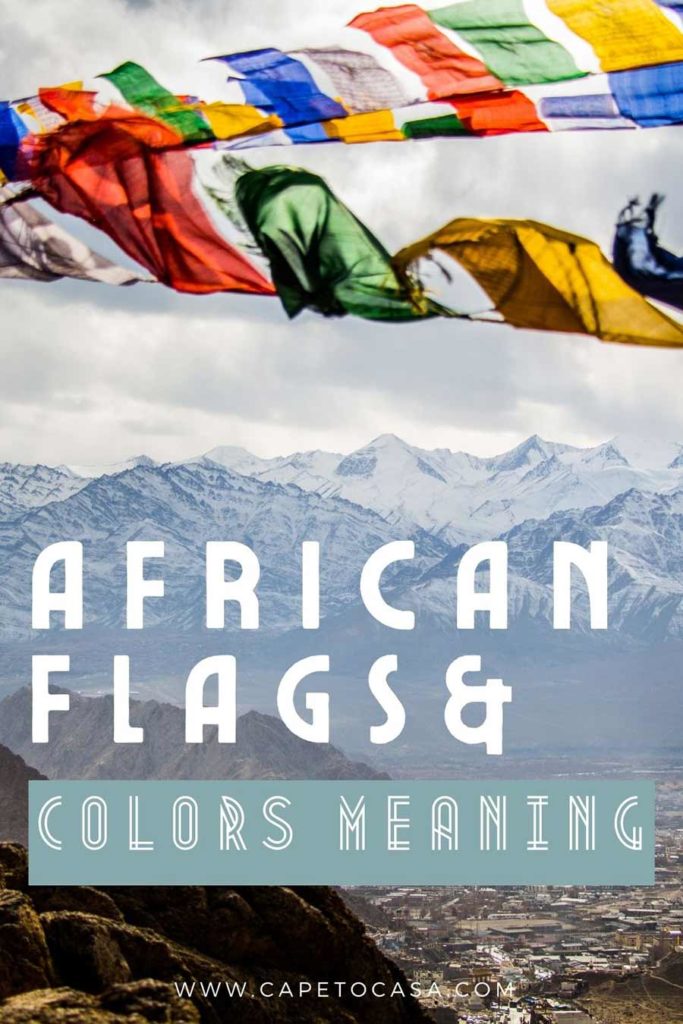The African flags and their colors represent the diversity of individual nations but also several common symbols of peace, hope prosperity, and freedom from oppression and colonization.
Most African flags can be traced back to the post-World War II transition period when several African countries succeeded in winning independence from European powers. There is also a strong similarity in many of the flags in this list that can be attributed to the colors and ideals of Pan-Africanism.
North African Flags and their meanings
Flag of Algeria
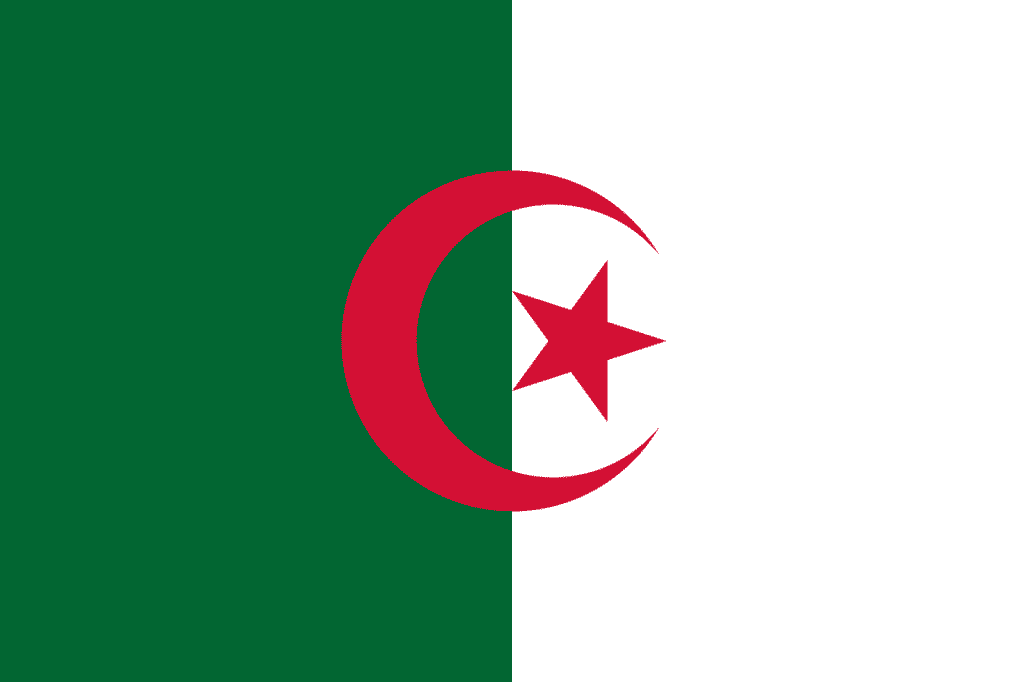
Description of the flag of Algeria: The Algerian flag features 3 main colors: Green, white and red, and 2 symbols, the star, and the crescent.
Meaning of the flag of Algeria: The Algerian flag is one of the African flags that hold the meaning of religion and beliefs. The green color of this African flag represents Islam, Algeria’s religion, and the white color represents peace and purity while the red color represents the blood of martyrs during the Algeria war, between 1954 and 1962. Finally, the star and crescent are also symbols of Islam.
The flag of Algeria was adopted on July 3, 1962
Flag of Egypt

Description of the flag of Egypt: The current Egyptian flag has three red black and white horizontal stripes, and a golden eagle placed in the center of the white stripe.
Meaning of the flag of Egypt: Like many other African flags the Egyptian flag tells the story of the past struggles of the country. The red color is a memorial of the sacrifices and blood of the martyrs, the white symbolizes peace and the black represents the dark period of occupation.
The eagle is a symbol of power and strength. These colors were inspired by Pan-Arabism.
The flag of Egypt was adopted on October 4, 1984
Flag of Libya
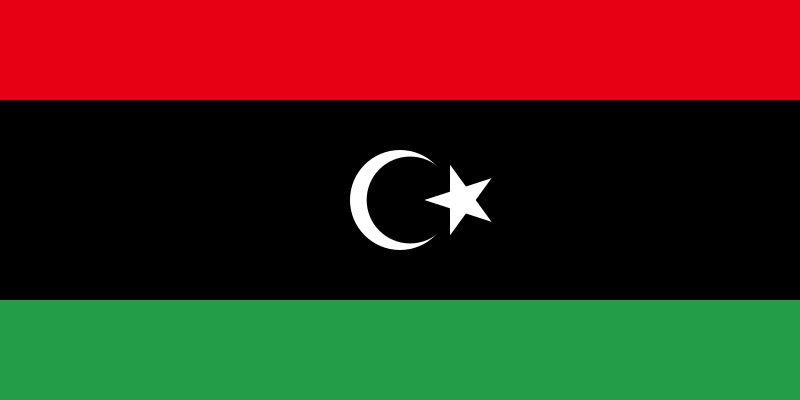
Description of the flag of Libya: The Libyan flag is a black field with a red stripe on the top and a green stripe at the bottom. There is a white crescent and star in the center.
Meaning of the flag of Lybia: The Libyan flag is an African flag of deep meanings and representation of the country’s history, religion, and resources. The black reminds people of the dark days of Italian occupation. The green represents Libya’s natural resources. The red is for the blood of the people who died for their country. The star and crescent are symbols of Islam. The crescent is the symbol of the Islamic lunar calendar.
The flag of Libya was re-adopted on 3 August 2011
Flag of Mauritania
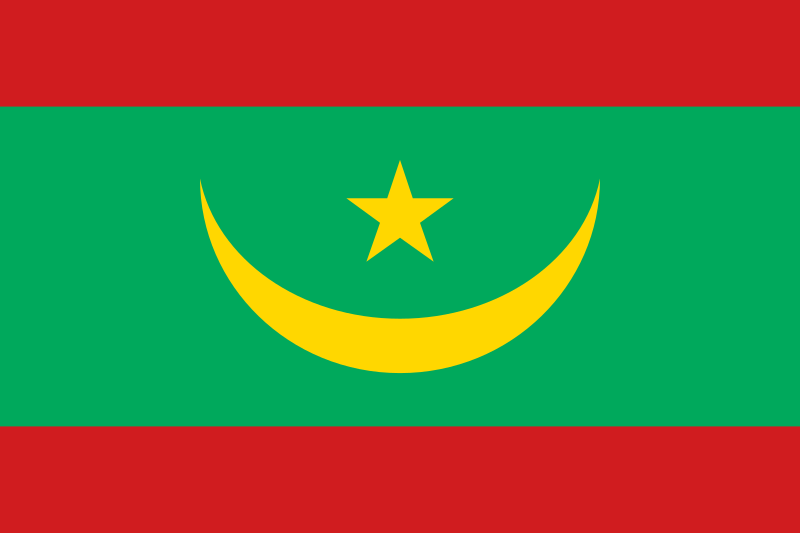
Description of the flag of Mauritania: The flag has a green field with a gold star and a crescent. There are red stripes running across the top and bottom of the flag.
Meaning of the flag of Mauritania: Green is a symbol of Islam. Gold represents the Sahara Desert. Red represents the blood and struggles of the people. The start and crescent are also common symbols of Islam.
Green, gold, and red are also considered to be Pan-African that many African flags share.
The flag of Mauritania was adopted on 15 August 2017
Flag of Morocco
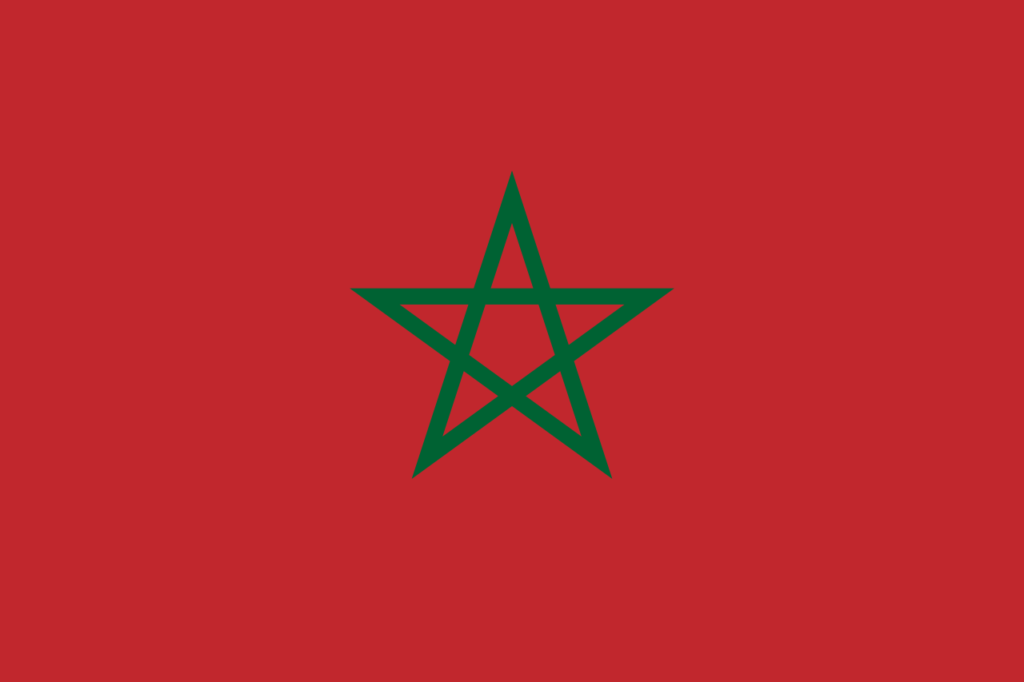
Description of the flag of Morocco: The flag of Morocco is a red field with a green pentagram star in the center.
Meaning of the flag of Morocco: Both Red and Green colors are associated with Islam. The green pentagram is drawn with five straight lines; each line represents one of the five pillars of Islam, Morocco’s religion. the green is also often associated with Islam.
The flag of Morocco was adopted on November 17, 1915
Flag of Tunisia
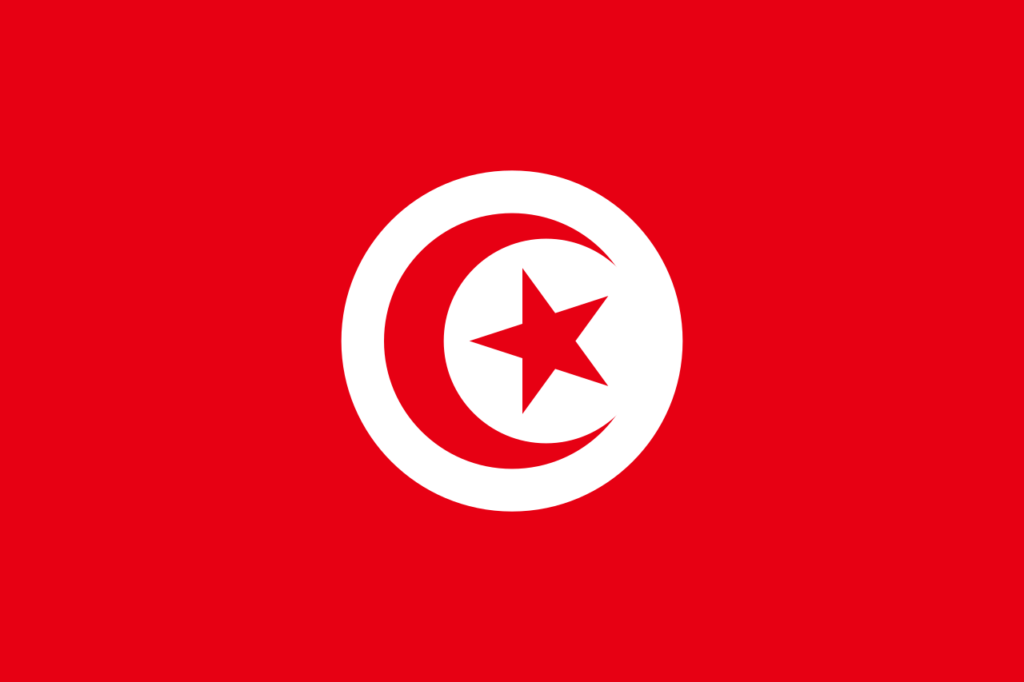
Descritpion of the Flag of Tunisia: The Tunisian flag a red background with a white circle in the center hodling a crecent and a star.
Meaning of the flag of Tunisia: Some say that the Tunisian flag is not only one of the oldest African flags but one of the oldest in the world. Being made in the 1830s, the red background is a symbol of Islam, the dominant religion in Tunisia.
The crescent is also a strong symbol of Islam, which was inherited from the country’s Ottoman influence and history. The white circle represents peace. The five-pointed star represents the five pillars of Islam.
The flag of Tunisia was adopted on October 20, 1959
South African Flags and their meanings
Flag of Angola
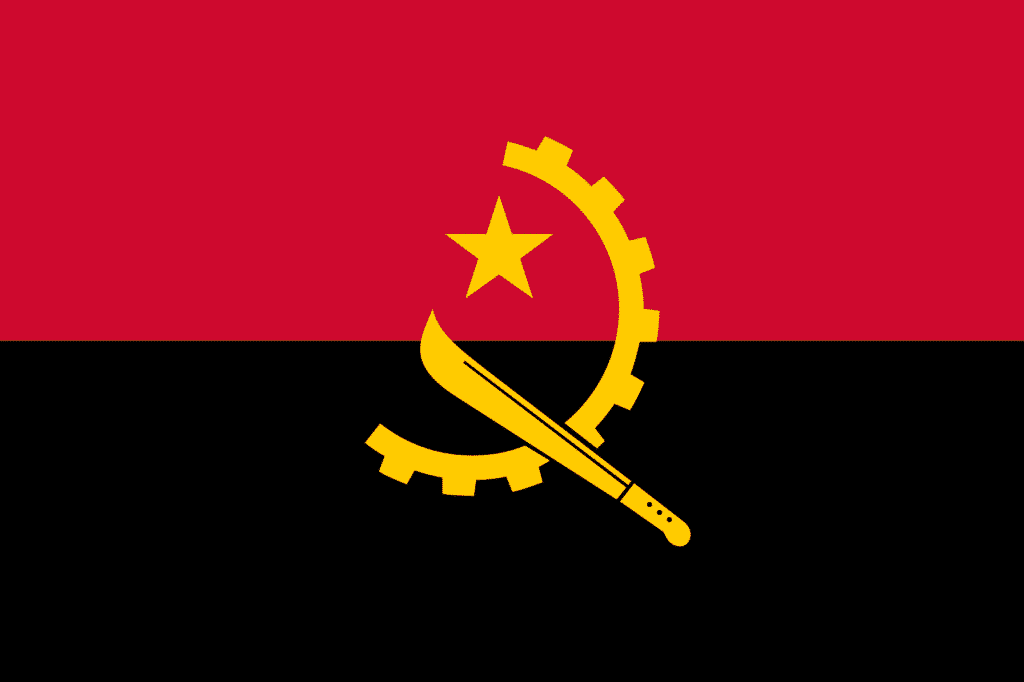
Description of the flag of Angola: Angola’s national flag is composed of two red and black horizontally stripes, and three yellow colored symbols: a star, a cogwheel and a machete placed in the center of the flag.
Meaning of the flag of Angola: Angola is an African country with rich heritage, diversity and painful colonial history. The Red color of the flag symbolizes bloodshed during the colonial oppression, Angola’s independence struggle as well as for the defense of the country; while the black color is meant to represent the people of Africa and the continent as a whole.
The yellow color of the emblem symbolizes the country’s wealt where the star symbolizes internationalism and progress, the cogwheel is for industrial workers, and the machete represents agricultural laborers.
The flag was adopted on November 11, 1975
Flag of Botswana
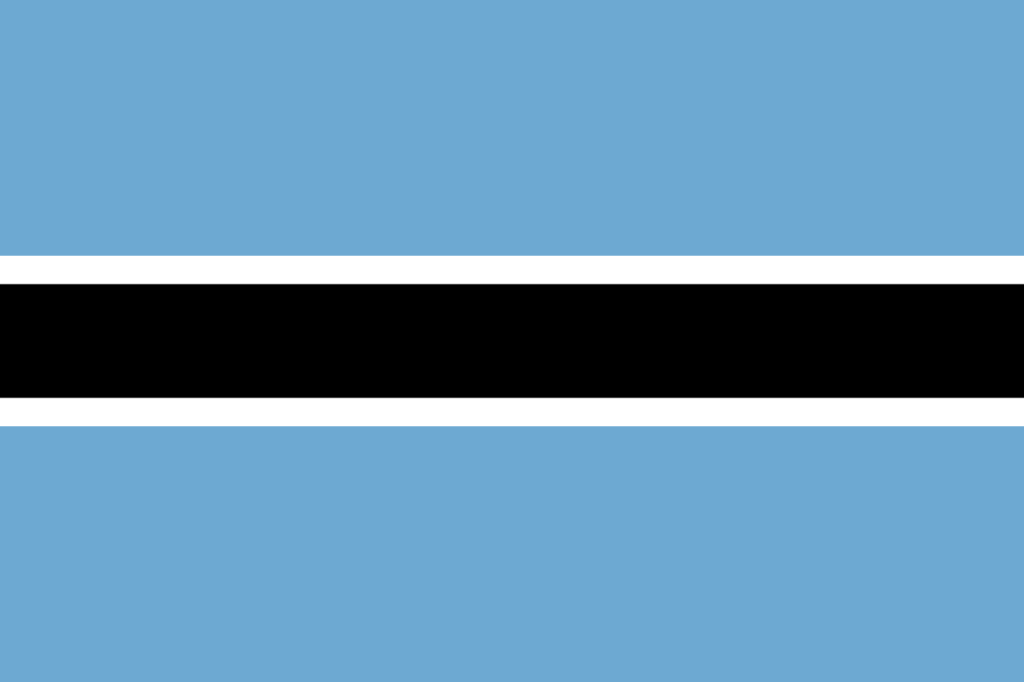
Description of the flag of Botswana: Botswana’s flag is one of the African flags that has a totally different panel of colors. It consists of three main colors sky blue, black, and white.
Meaning of the flag of Botswana: The central black stripe and the white bordering stripes of this unique African flag represent a belief in racial cooperation and equality. The light blue background of the flag is associated with the sky and water, a scarce and precious commodity in the vast Kalahari desert.
The flag of Botswana was adopted on September 30, 1966
Flag of Lesotho
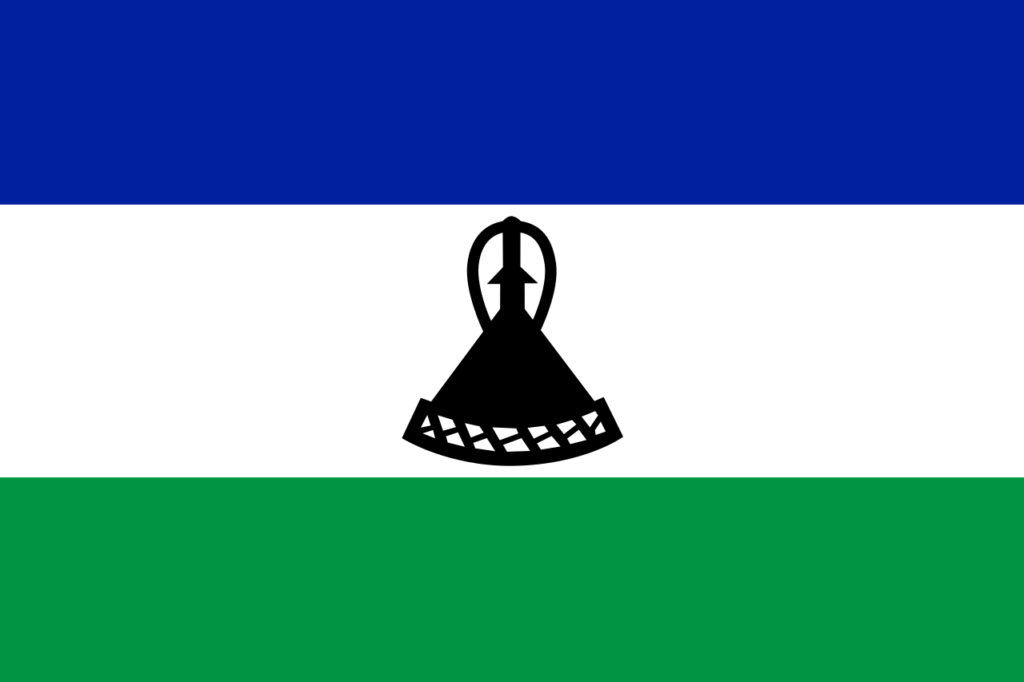
Description of the flag of Lesotho: The flag of Lesotho is one of the very unique and interesting African flags. uncharacteristically, it has cool colors: blue, white, and green. The symbol at the center is a Mokorotlo, a traditional Basotho hat.
Meaning of the flag of Lesotho: In the flag of Lesotho, the blue represents the sky and rain, the white represents peace and the green represents prosperity. The Mokorotlo replaced the previous symbol, which was a shield, as a sign of peace.
The flag of Lesotho was adopted on September 18, 2006
Flag of Malawi

Description of the flag of Malawi: The flag of Malawi has three horizontal stripes: black, red, and green. The also has a half red sun symbol on the black stripe.
Meaning of the flag of Malawi: The black on the flag of Malawi represents the indigenous people of the country. The red represents the blood of the people and the green represents nature. The rising sun represents hope and freedom for Africa.
The sun has 31 rays to represent the 31 independent nations of Africa, at that time. The flag of Malawi bears a close resemblance to the flag of the early Pan-African movement of Marcus Garvey, The Universal Negro Improvement Association.
The flag of Malawi was adopted on 6 July 1964
Flag of Mozambique
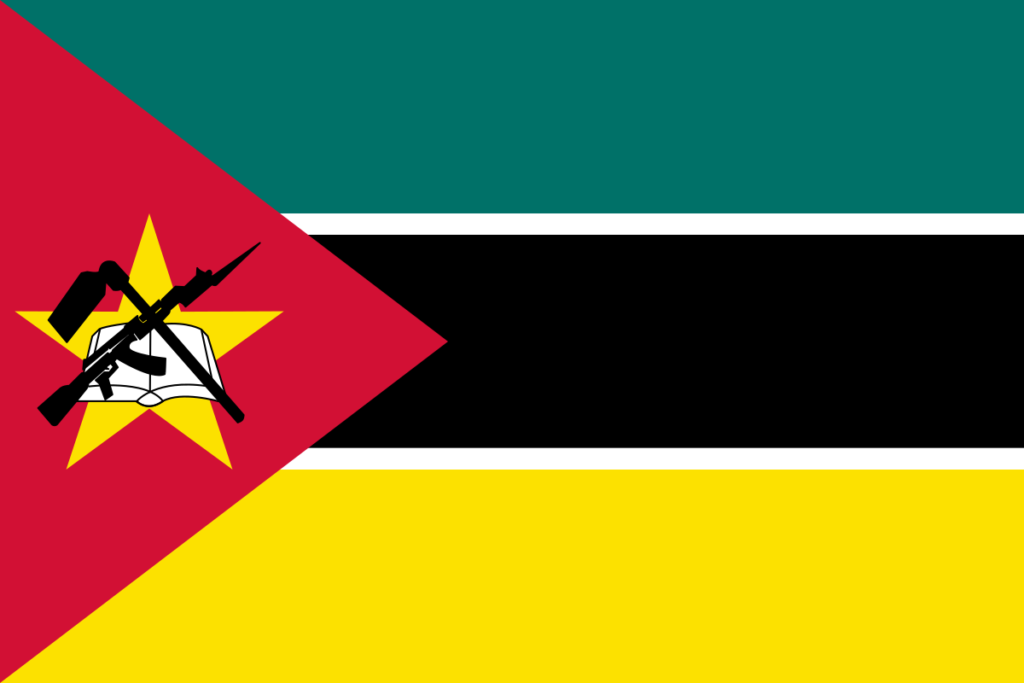
Description of the flag of Mozambique: The flag of Mozambique is a very busy African flag that has an interesting tricolor of green, black, and yellow with a red triangle on the hoist. The middle stripe is bordered by two white stripes. There is also a yellow star on the hoisted triangle and within that triangle, there is a black Kalashnikov rifle, a black farming hoe, and a white open book.
Meaning of the flag of Mozambique: Green represents the country’s rich land and white stands for peace. The black represents the African continent while the yellow is a symbol of Mozambique’s minerals. The hoe highlights the importance of agriculture. the book represents education and the rifle show defense and vigilance. The star represents Marxism.
The flag of Mozambique was adopted on 1 May 1983
Flag of Namibia

Description of the flag of Namibia: The Namibian flag is a red diagonal stripe that separates two right-angle triangles on the top-left and bottom-right, blue and green respectively. The red stripe is bordered by two white lines. The top left corner has a yellow sun.
Meaning of the flag of Namibia: Red represents the people of Namibia. White stands for peace and unity. Green represents the agricultural riches of the nation. Blue represents the Atlantic ocean and the sky. The yellow sun is a symbol of life and energy.
The flag of Namibia was adopted on 21 March 1990
Flag of South Africa
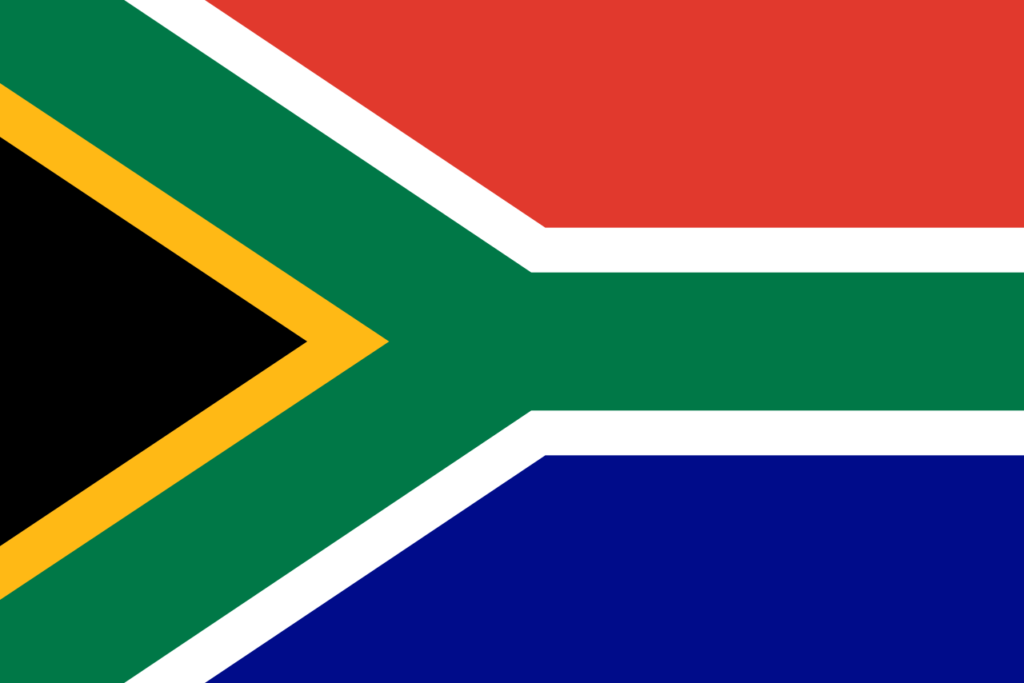
Description of the flag of South Africa: The South African flag is another interesting African flag as it combines several different influences and it is one of two African flags to feature 6 different colors.
A thick green Y shape runs along the center of the flag, separating two parts of red and blue. The green Y is bordered with narrow white stripes. On the left of the flag, the Y shape encloses a black triangle, bordered with gold. This is one of the only flags in the world that has 6 colors.
Meaning of the flag of South Africa: Officially, South Africans don’t attach any special meaning to the individual colors of their flag, beyond the general idea of peace and unity for all people.
According to other reports the colors have the following meanings: Black represents the African people. The gold represents the natural resources of South Africa, the most important commodity being ‘gold’ itself.
The green represents unity and nature. The red represents the blood of the people who died in the struggle against Apartheid. The blue represents the sky and the two oceans, The Atlantic and Indian Oceans. Finally, white is a symbol of peace.
The flag of South Africa was adopted on April 27, 1994
Flag of Swaziland
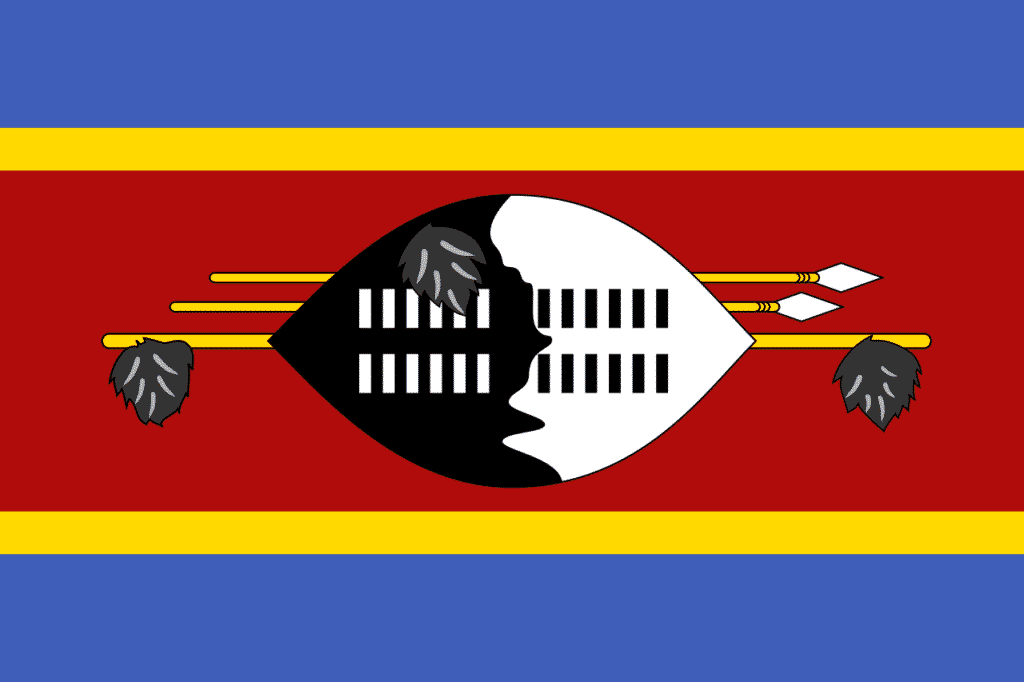
Description of the flag of Swaziland: The flag has five horizontal stripes—two blue stripes at the top and bottom while the center stripe is red. Two thin yellow stripes border the red stripe. On the red stripe is an ox hide combat shield from the traditional Swazi Emasotsha Regiment, laid horizontally. The shield is reinforced by a staff from which hangs Injobo tassels-bunches of feathers of the widowbird and the lourie. Above the staff are two assegais-local spears.
Meaning of the flag of Swaziland: The central focus of the flag of Swaziland is a Nguni shield and two spears, symbolizing protection from the country’s enemies. Its color is meant to show that white and black people live in peaceful coexistence in Eswatini. The red stands for past battles, the blue for peace and stability, and the yellow for the resources of Eswatini.
The flag of Eswatini (Swaziland) was adopted on October 6, 1968
Flag of Zambia
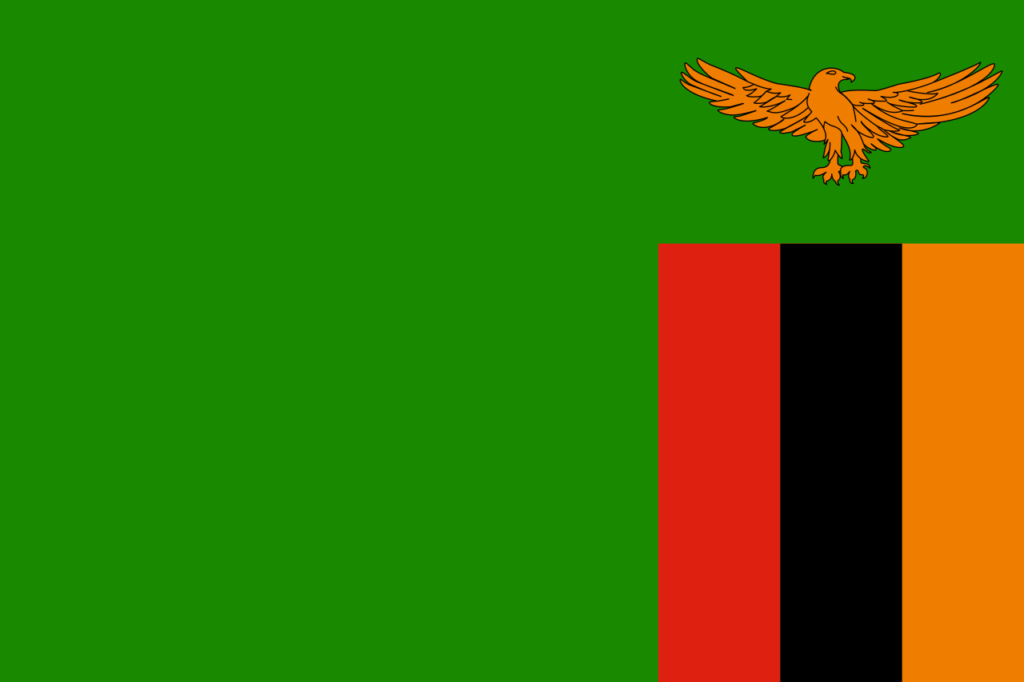
Description of the flag of Zambia: The Zambian flag is a green field with an orange-coloured African fish eagle in flight over a rectangular block of three vertical stripes, coloured, from left to right: red, black and orange.
Meaning of the flag of Zambia: Zambia’s flag colors have an interesting meaning and symbolism. The dominant green background symbolizes the country’s rich vegetation and agricultural wealth. The red stripe represents the struggle and bloodshed during the fight for the country’s liberation from colonial rule. The black stripe is a symbol of the original people of the land. The bright orange holds the meaning of Zambia’s wealth in copper which is the most important industry in the country. The orange bird is an African Fish-eagle, a symbol of freedom, as well as the people’s ability to rise above whatever challenges that they may face as a nation.
The flag of Zambia was adopted on October 24, 1964
Flag of Zimbabwe
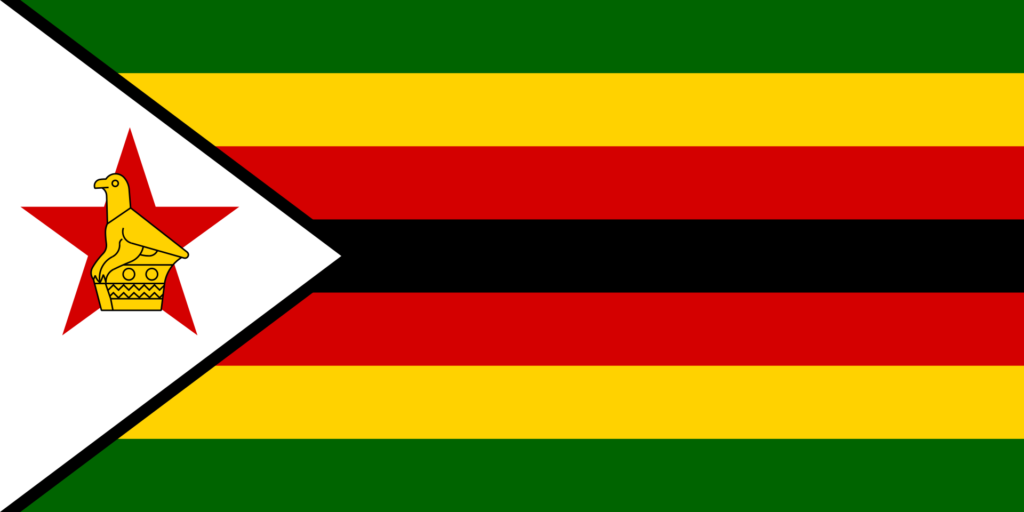
Description of the flag of Zimbabwe: The Zimbabwean flag is characterized by many colors that represent the country’s difficult past and bright future.
Meaning of the flag of Zimbabwe: The green-colored stripes of the Zimbabwean flag represent vegetation and agriculture. The yellow/gold represents the country’s rich mineral wealth. The red stripes represent the bloodshed during the war of liberation and independence. The black represents the black majority in Zimbabwe, as a sense of pride and African identity. The white triangle represents peace. The Zimbabwean Bird represents the National Emblem. Finally, the red star represents the nation’s aspirations.
The flag of Zimbabwe was adopted on April 18, 1980
West African Flags and their meanings
Flag of Benin Flag

Description of te flag of Benin: Benin flag is one the many African flags to feature the traditional Pan-African colors (red-yellow-green). The flag flag consists of two horizontal yellow and red bands on the fly side and a green vertical band at the hoist.
Meaning of the flag of Benin: The colors of the flag carry cultural, political, and regional meanings. The symbolism of the colors of the flag are explained in the national anthem, namely green recalls hope and revival, red the blood of ancestors and yellow is a reminder to preserve the country’s wealth.
The flag of Benin was adopted on November 16, 1959
Flag of Burkina Faso
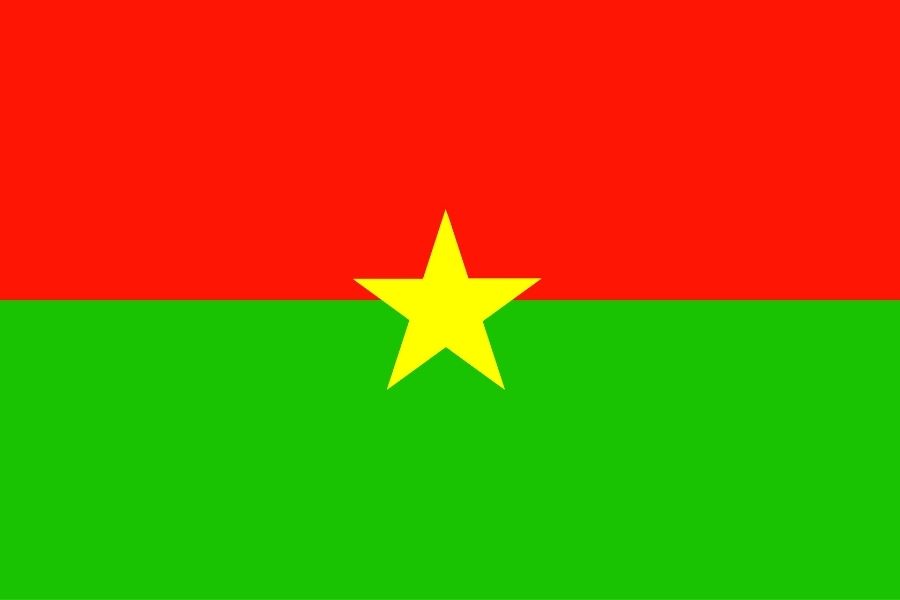
Description of the flag of Burkina Faso: The national flag of Burkina Faso is formed by two equal horizontal bands of red and green, with a yellow five-pointed star resting in the center.
Meaning of the flag of Burkina Faso: Along with many other African flags in the region, Burkina Faso flag follows the Pan-African colour-scheme, based on Ethiopia’s national colours. The green symbolizes the country’s fertile land, while red symbolizes the blood that flows during the revolution and the nation that loses its life.
Flag of Cape Verde
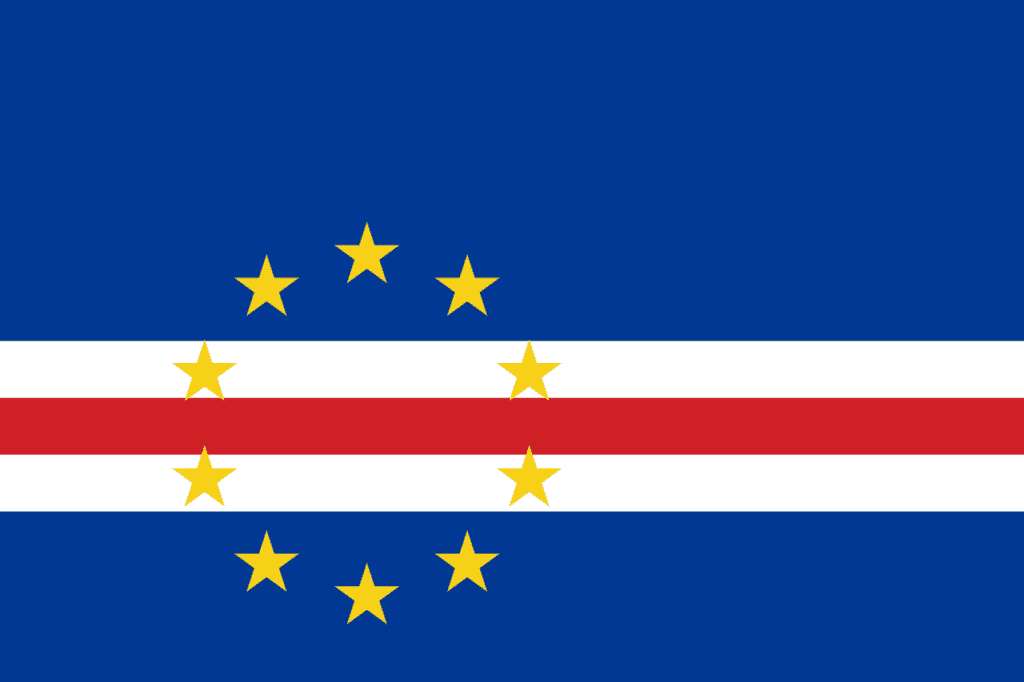
Description: The National Flag of the Republic of Cape Verde has five unequal horizontal bands of blue, white, and red, with a circle of ten yellow five-pointed stars, all pointing upwards.
Colors Meaning: The 10 stars on the flag represent the main islands of the nation (a chain of islands off the coast of West Africa). The blue represents the ocean and the sky. The band of white and red represents the road toward the construction of the nation, and its colors stand for peace (white) and effort (red). The circle of yellow stars on a dark blue field is similar to the flag of Europe.
The flag of Cape Verde was adopted on September 22, 1992
Flag of Ivory Coast
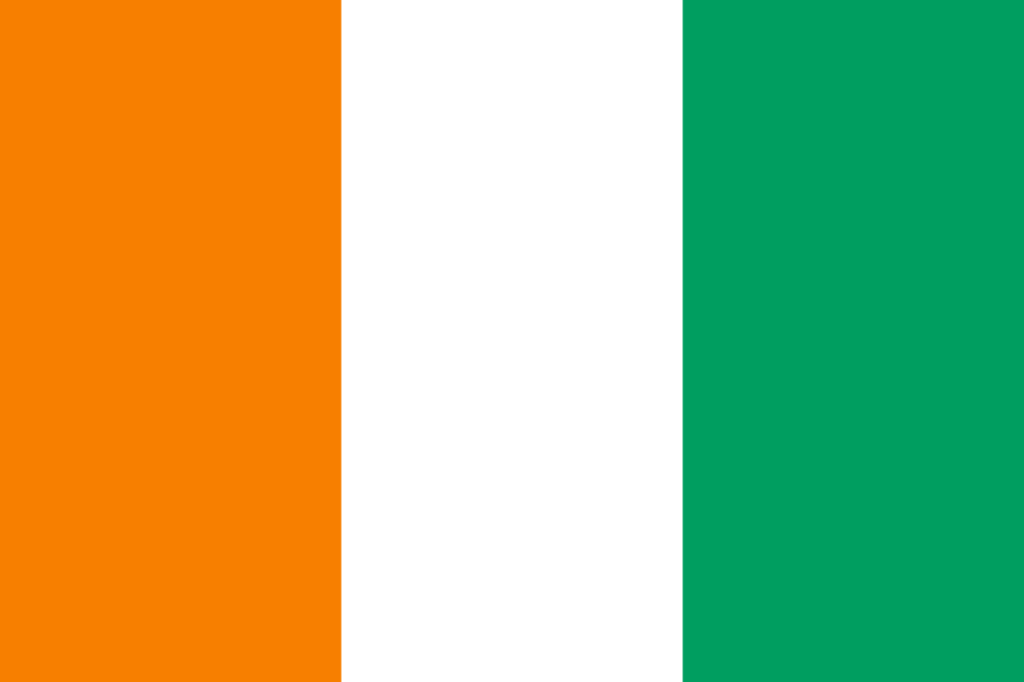
Description: The flag has three vertical stripes, similar to their colonizing power, France. However, the colors are green, white, and orange
Colors Meaning: The orange represents the fight for freedom and emancipation. The White represents peace and unity. The green represents the country’s hope for a better future.
The flag of Ivory Coast was adopted on December 3, 1959
Flag of Gambia
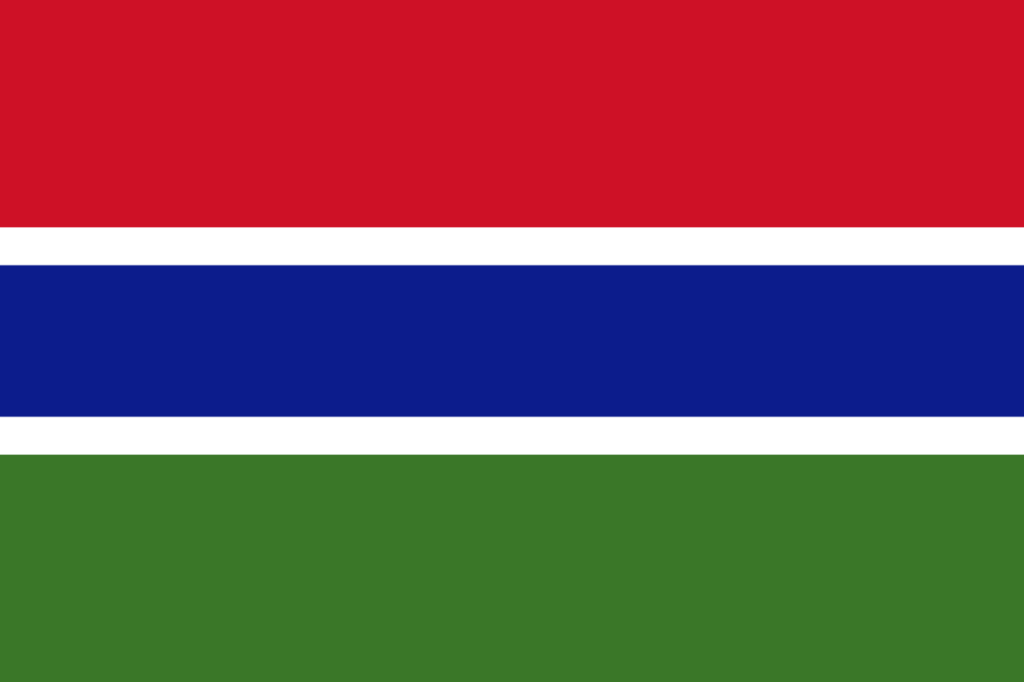
Description: This African country decided to break the regular tricolor horizontal convention by adding thing white borders to its blue stripe in the middle.
Colors Meaning: The blue stripe represents the River Gambia, which flows through the country and brings life to the people and animals. Red symbolizes the sun and the savannah. Green represents the countries rich nature and agriculture while the white stripes represent peace.
The flag of Gambia was adopted on February 18, 1965
Flag of Ghana
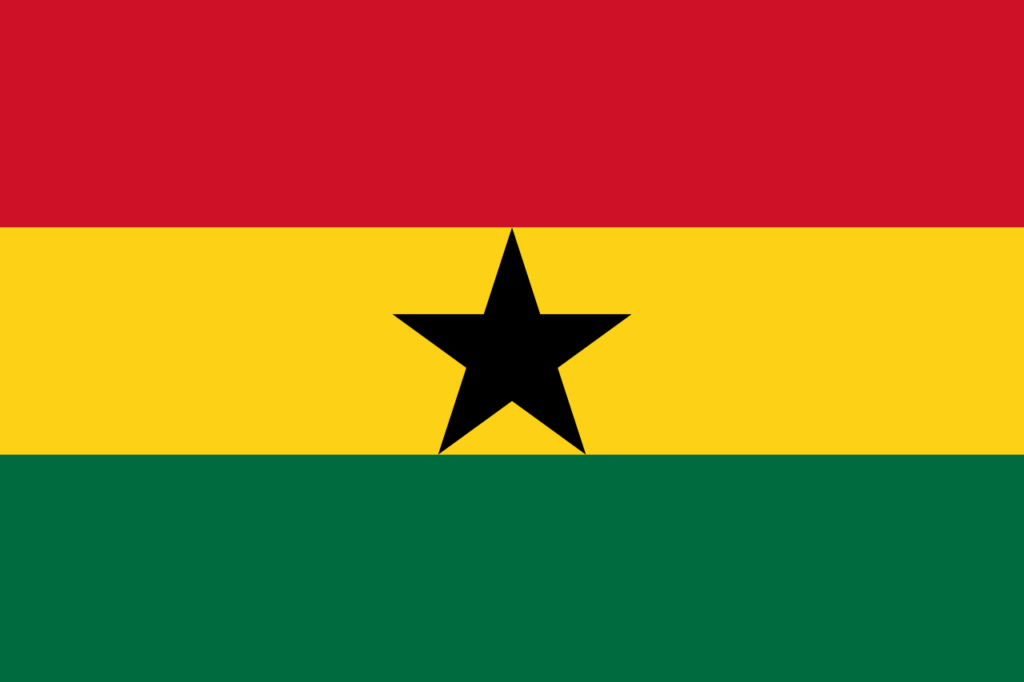
Description: In classic fashion, Ghana too has three horizontal stripes that resemble the Pan-African colors: green, gold and red. They also have a black star in the middle.
Colors Meaning: The black star represents the lodestar of African freedom. The gold stands for the country’s wealth. The red memorializes the blood of the people who died during the struggle for freedom. The green symbolizes Ghana’s rich and dense forests.
The flag of Ghana was adopted on February 28, 1966
Flag of Guinea
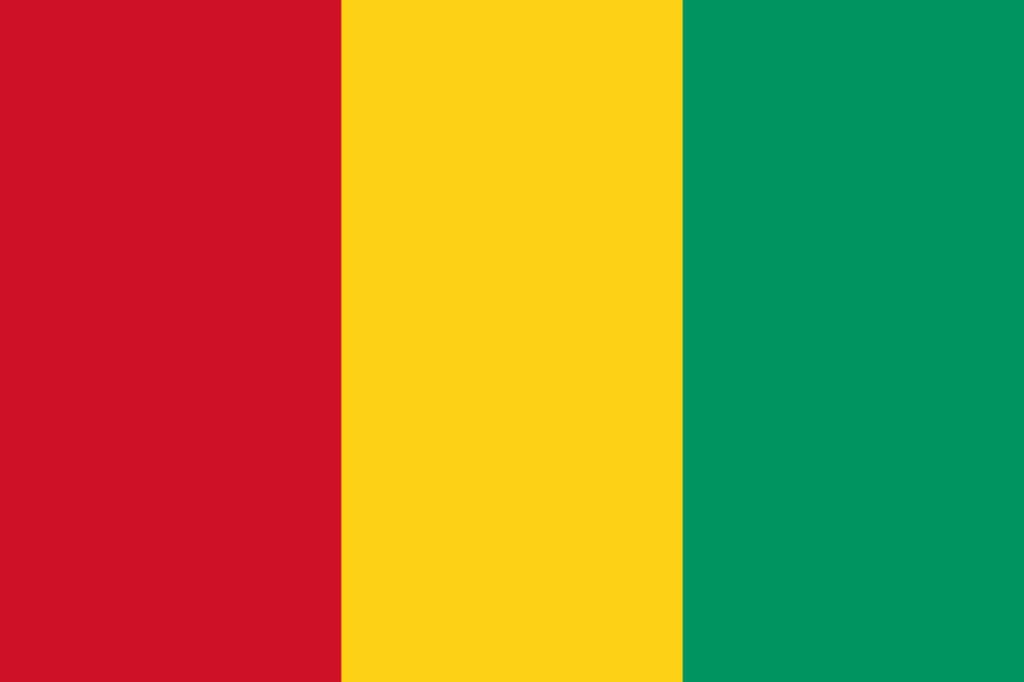
Description: Once again we see the strong Pan-African influence of Guinea’s flag. It has three vertical stripes that are red, yellow and green.
Colors Meaning: Red symbolizes the blood of the martyrs that died due to slavery and wars. Yellow represents the countries sunshine and riches. Green represents the country’s vegetation.
The flag of Guinea was adopted on November 10, 1958
Flag of Guinea-Bissau

Description: The flag of Guinea-Bissau has the three conventional Pan-African colors yellow and green horizontally and a red band vertically on the left side. There is also a black star, left of center.
Colors Meaning: The black star represents the freedom of the people. The yellow represents the sun. The green represents agriculture and vegetation. It also represents hope. The flag has been influenced to a large degree by the flag of Ghana.
The flag of Guinea-Bissau was adopted on September 24, 1973
Flag of Liberia
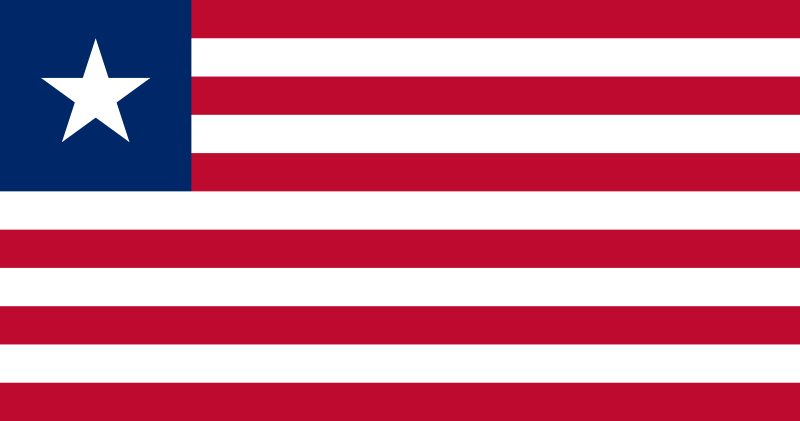
Description: Similar to the flag of The U.S.A, the flag of Liberia has red and white stripes and a blue square in the top left corner. It only has 1 white star.
Colors Meaning: The eleven stripes symbolize the signatories of the Liberian Declaration of Independence. The red and white represent courage and moral excellence. The white star represents the first free nation in Africa. The blue square represents the continent of Africa.
The flag of Liberia was adopted It was adopted on 24 August 1847
Flag of Mali
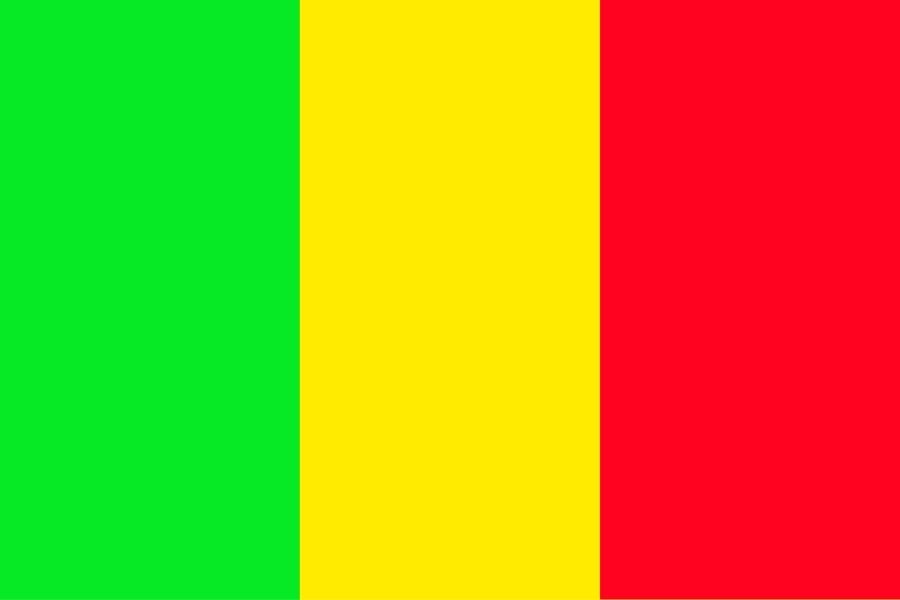
Flag of Niger

Description: A horizontal tricolor of orange, white and green, with an orange circle in the center.
Colors Meaning: Red represents the Saharah of the north while green represents the fertile regions of the south. The white band stands for purity. The orange circle represents the sun.
The flag of Niger was adopted on 23 November 1959
Flag of Nigeria
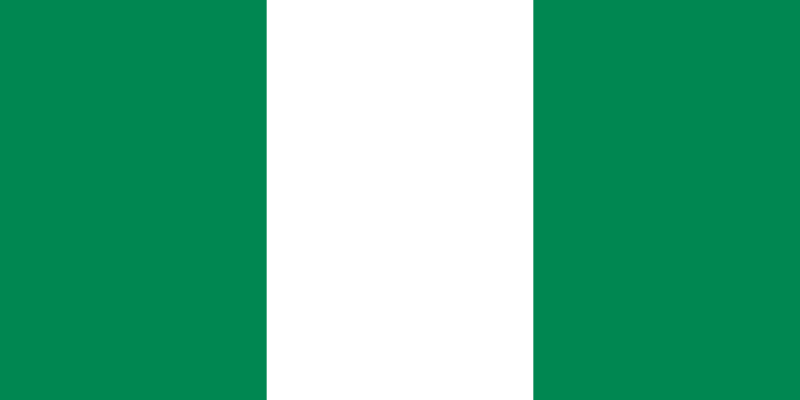
Description: The flag of Nigeria is a tricolor of three vertical bands of green, white and green.
Colors Meaning: The greens represent the country’s natural wealth while the white represents peace and unity.
The flag of Nigeria was adopted on 1 October 1960
Flag of Senegal
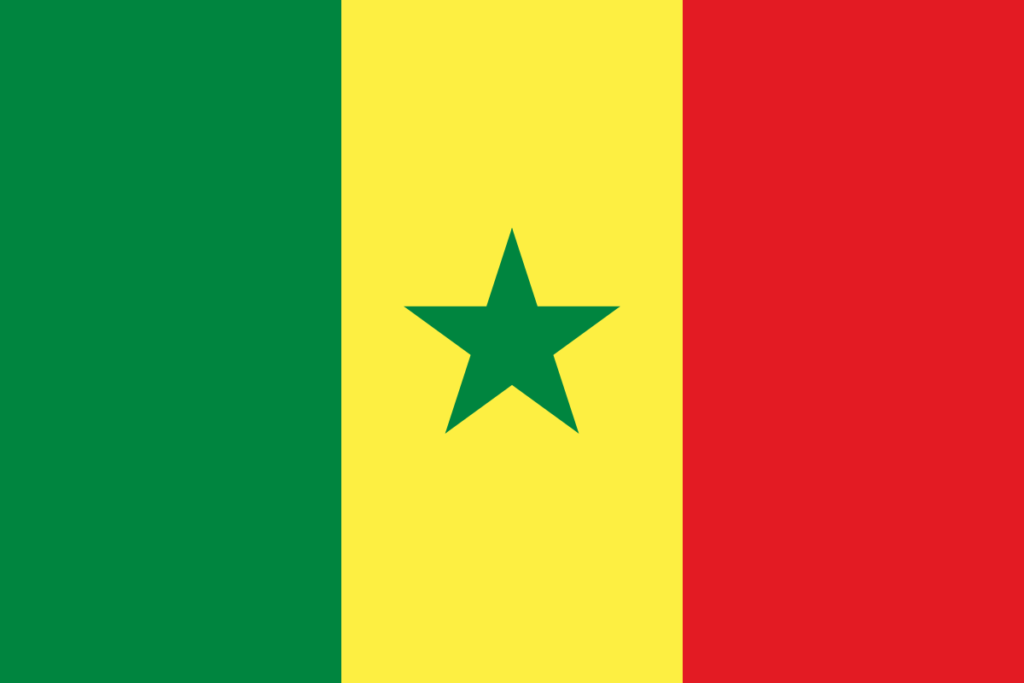
Description: A typical Pan-African flag with a vertical tricolor of green, yellow and red, not forgetting the green five-pointed star in the center.
Colors Meaning: The green stripe and the star represent Islam and the prophet Mohammed. Yellow represents the wealth of the nation. Red is used to remember the blood and sacrifices made by the people in the past.
The flag of Senegal was adopted in 1960
Flag of Sierra Leone
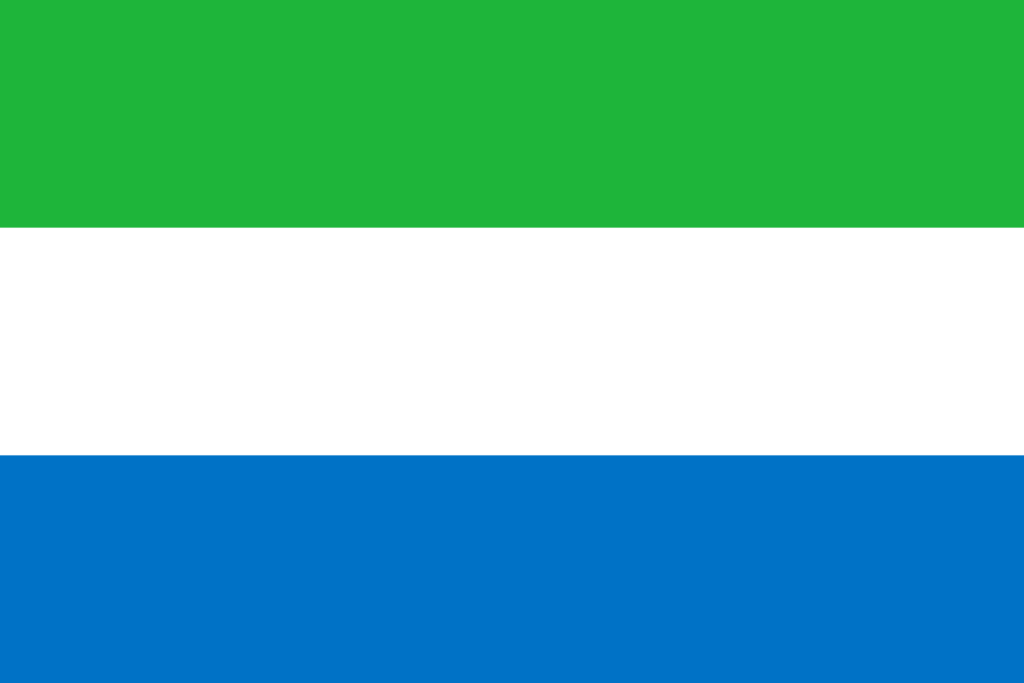
Description: The flag of Sierra Leone is a horizontal tricolor of green, white and blue.
Colors Meaning: The colors carry meanings that carry cultural, political, and regional significance. The green symbolizes Sierra Leone’s natural resources. The white stands for unity and justice. The light blue marks the harbor of Freetown and also represents world peace.
The flag of Sierra Leone was adopted in 1961
Flag of Togo
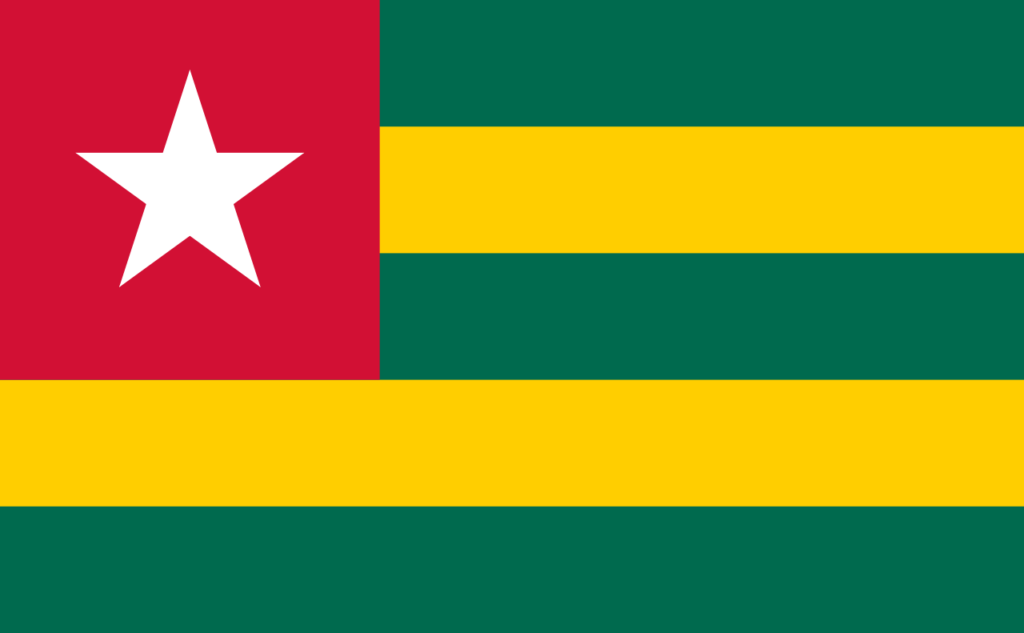
Colors Meaning: Togo’s five stripes represent the 5 administrative regions. The green represents the vegetation while the yellow symbolizes labor. The red square is a sign of love, while the white represents purity.
The flag of Togo was adopted on April 28, 1960
East African Flags and their meanings
Flag of Comoros

Description: The design consists of a white crescent with four white five-pointed stars inside of a green triangle. The flag has four stripes,
Colors Meaning: The four stripes of the Comoros national flag represents the four islands of the nation: yellow is for Mohéli, white is for Mayotte, Red is for Anjouan, and Blue is for Grande Comore. The four stars on the flag also symbolize the four islands of Comoros. The star and crescent symbols stand for their main religion, Islam.
The flag of Comoros was adopted on December 23, 2001
Flag of Djibouti

Description: The national flag of Djibouti is a horizontal flag bicolor with equal bands of light blue and light green, with a white, equilateral triangle at the hoist. In the center of the triangle is a red star. The flag of Djibouti features two equal horizontal bands of blue (top) and green, with a white isosceles triangle based on the hoist side.
Colors Meaning: The light blue represents the sky and the sea, as well as the Dir Somalis, green represents the everlasting green of the earth, as well as the Afars, white represents the color of peace and the red star represents the unity and the bloodshed by the martyrs of independence.
The flag of Djibouti was adopted on June 27, 1977
Flag of Ethiopia
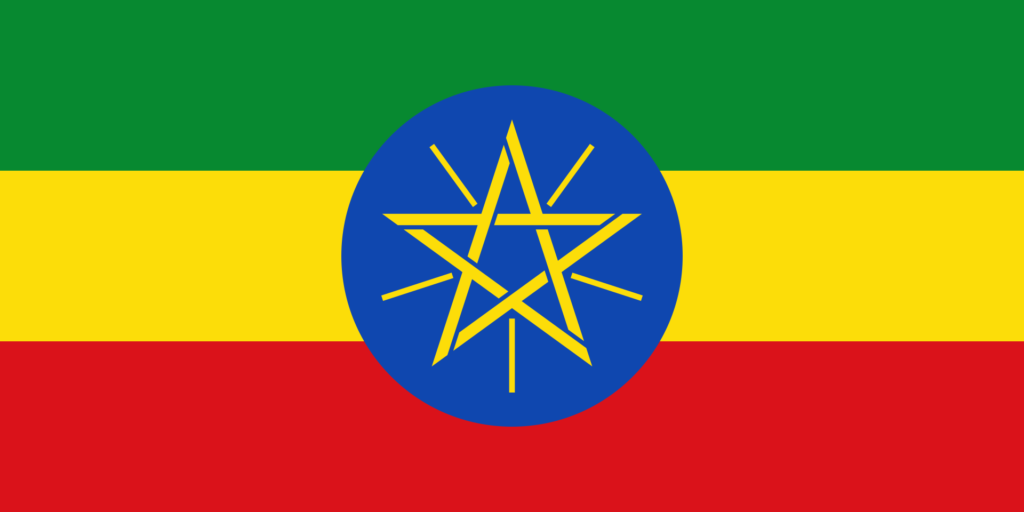
Description: The flag has three horizontal stripes of the Pan-African colors, green, yellow and red, in addition to a blue circle that includes the national emblem.
Colors Meaning: the blue represents peace while the yellow represents hope, justice and equality. The red represents the sacrifice for freedom and equality. The green symbolizes labor, development and fertility. The star represents all the unity of all Ethiopian nations and groups.
The flag of Ethiopia was adopted on October 31, 1996
Flag of Eritrea
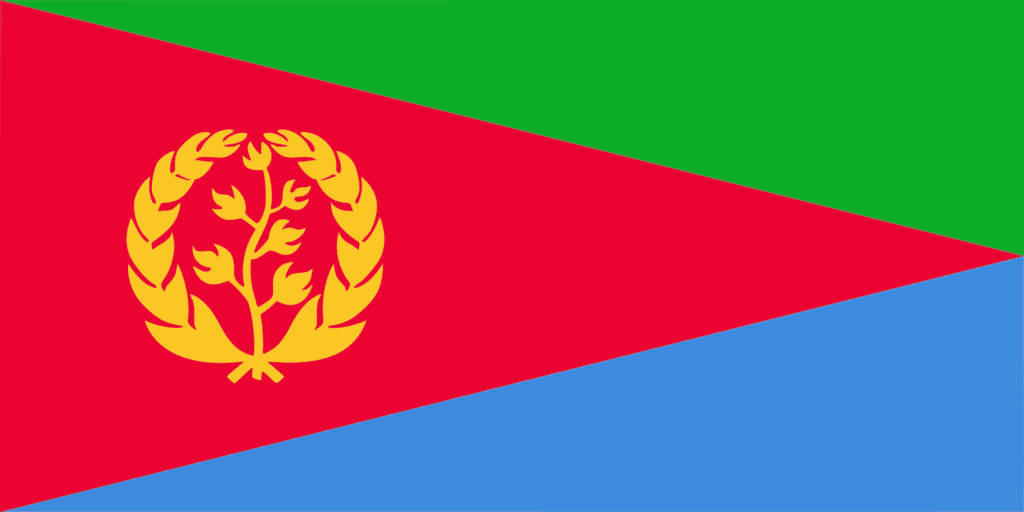
Description: The flag consists of 3 triangles and an olive branch. It’s very original.
Colors Meaning: The widening green flag stands for the increasing growth in agriculture and food security. The red represents the bloodshed and people that died during the struggle for liberation. The increasing blue represents the growing preservation and exploration of the Read Sea. The olive branch represents the 9 ethnic groups and 9 languages in Eritrea. The outer wreath represents the 30 years of their struggle for independence.
The flag of Eritrea was adopted in 1995
Flag of Kenya
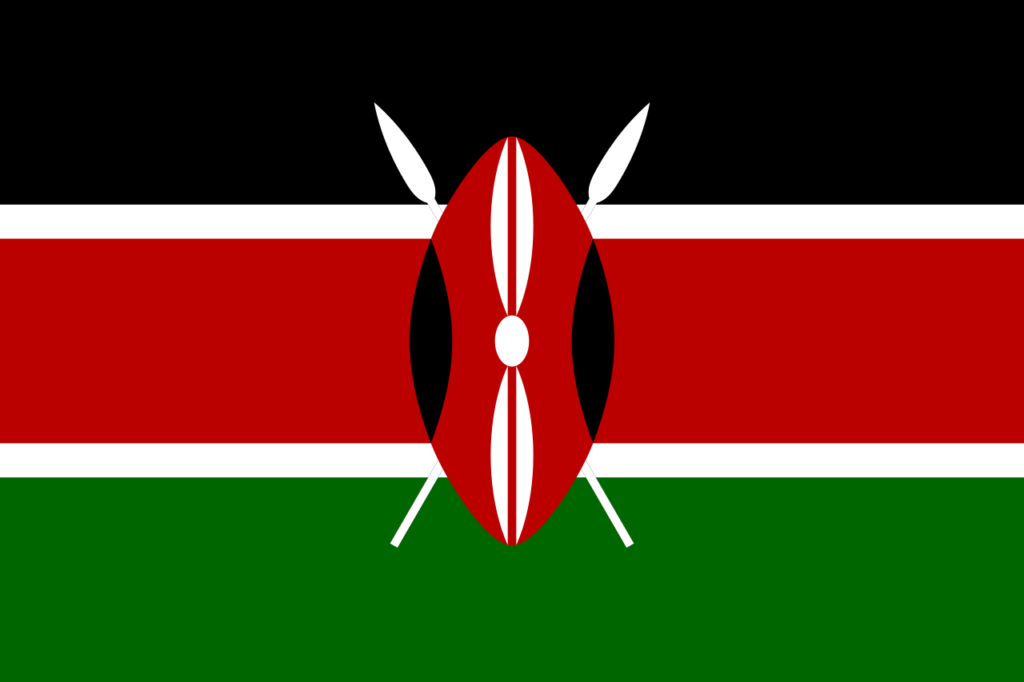
Description: the Keyan flag is unique in its colors and design. It has three horizontal bands, black red and green. The middle band is bordered with two white stripes. At the center lies a Masai Shield and two spears.
Colors Meaning: The black represents the ethnicity and culture of the people of Kenya. The red is a memory of the people who died during the struggle for freedom. The white means peace and honesty. The green represents the country’s vast landscape. The shield and spears highlight the country’s commitment to defending their nation and their freedom.
The flag of Kenya was adopted on December 12, 1963
Flag of Madagascar
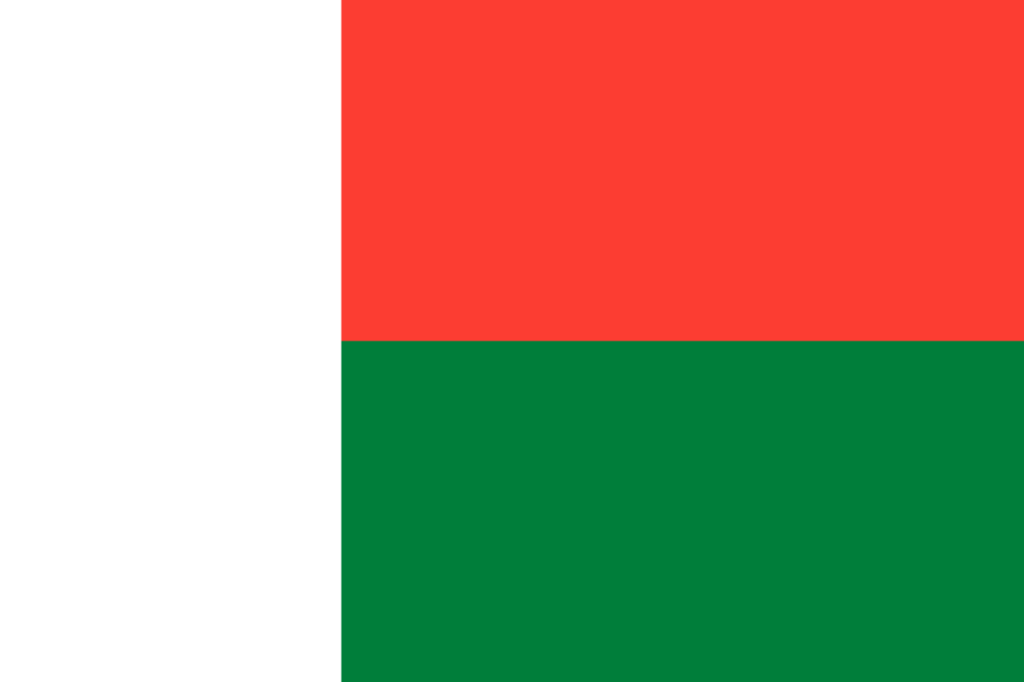
Description: Two horizontal bands of red and green with a vertical white band on the hoist.
Colors Meaning: Red and white were the colors of the previous Merina kingdom. Green was the color of the Hova, the largest class of peasants who were instrumental in fighting for independence.
The flag of Madagascar was adopted on 14 October 1958
Flag of Mauritius
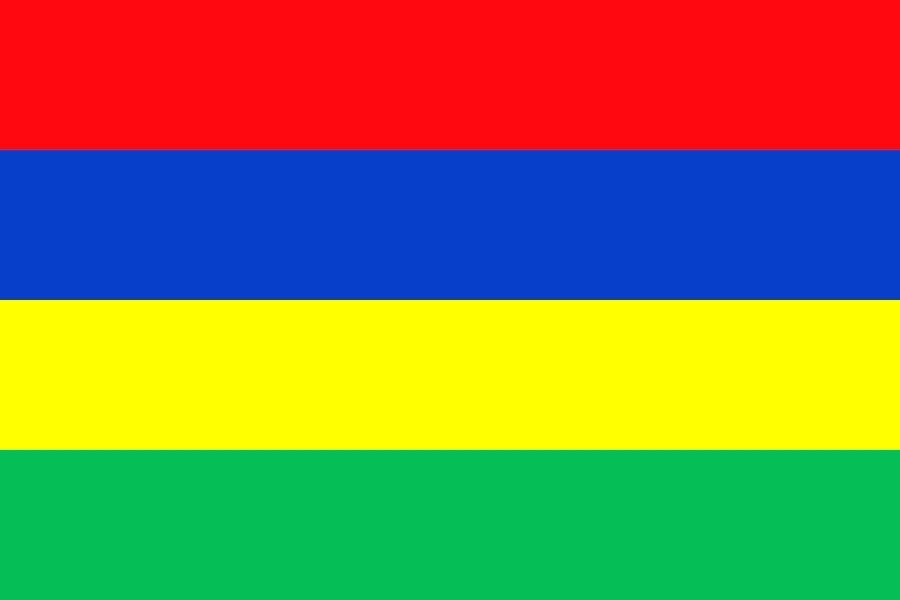
Flag of Rwanda

Description: the flag consists of 3 horizontal bands of light blue, yellow, and green. There is an image of a yellow sun in the top right corner.
Colors Meaning: The blue represents happiness and peace. The yellow represents economic development and the green represents hope and prosperity. The sun symbolizes enlightenment.
The flag of Rwanda was adopted in 2001
Flag of Seychelles
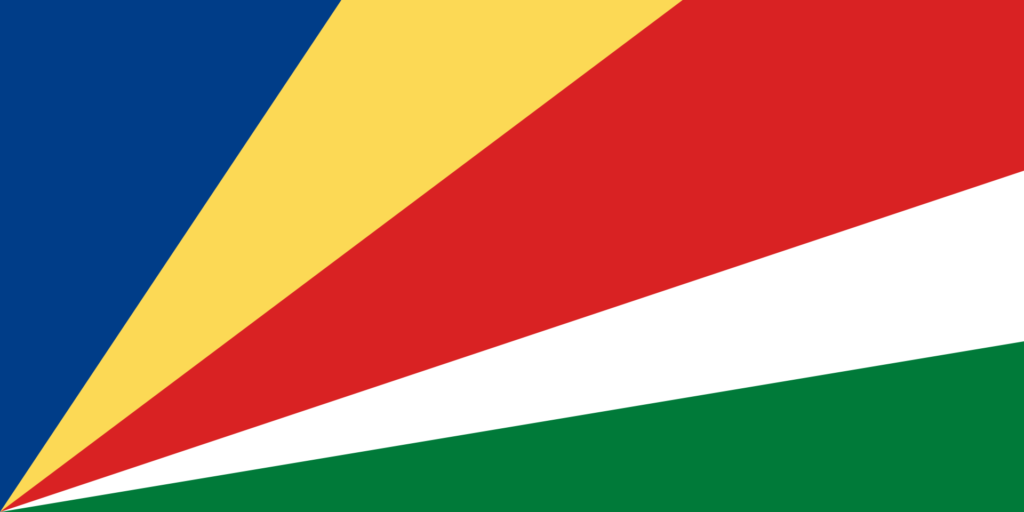
Description: One of the more colorful African flags, The Republic of Seychelles flag has 5 diagonal bands growing out of the bottom left corner, namely: blue, yellow, red, white, and green.
Colors Meaning: The direction of the bands signals the country’s dynamic and ambitious future. Blue depicts the sky and surrounding sea. the Yellow band represents the sun which gives light and life. Red shows the love and unity of the people. White is for social justice and harmony. Finally, the green symbolizes the nature and land of Seychelles.
The flag of The Republic of Seychelles was adopted on 8 January 1996
Flag of Somalia
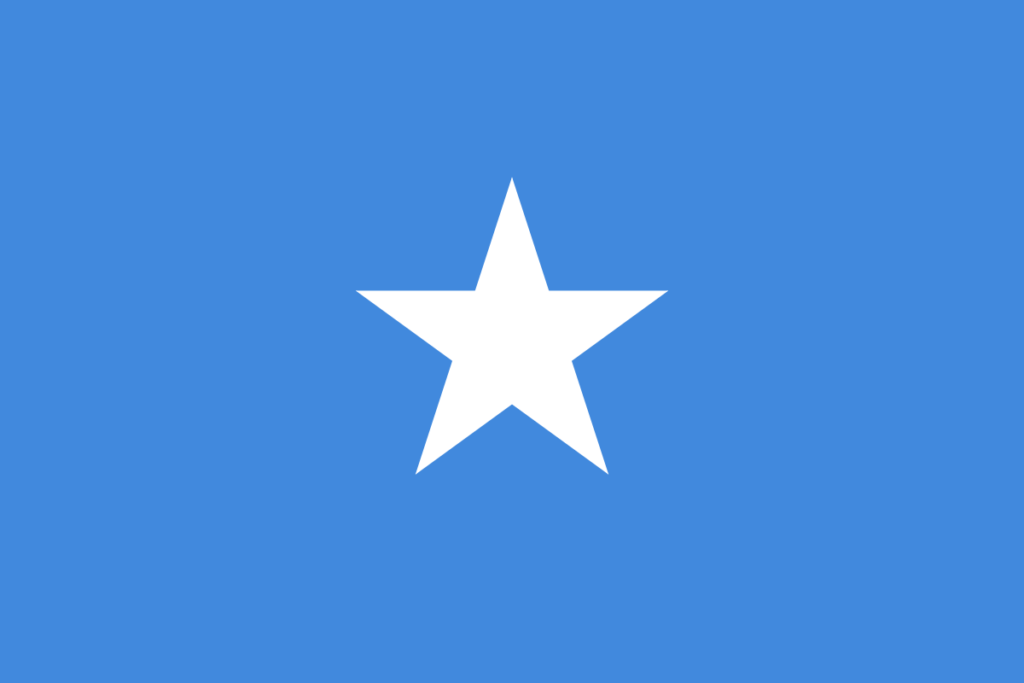
Description: A solid light blue flag with a white five-pointed star in the middle.
Colors meaning: the blue represents the sky and also the Gulf of Aden. The white star represents unity. Some say that the flag was intentionally designed to closely resemble the flag of the United Nations.
The flag of Somalia was adopted in 1954
Flag of South Sudan
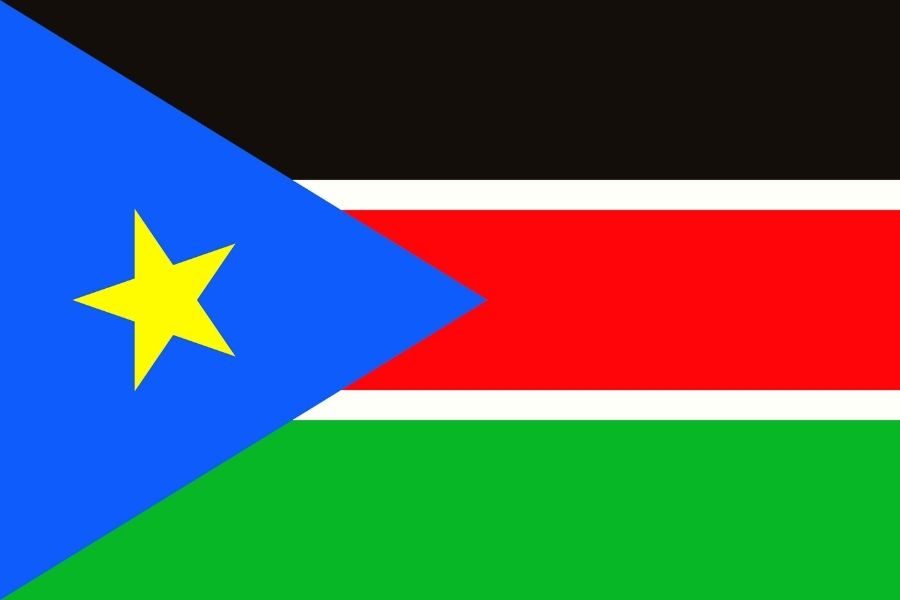
Flag of Sudan
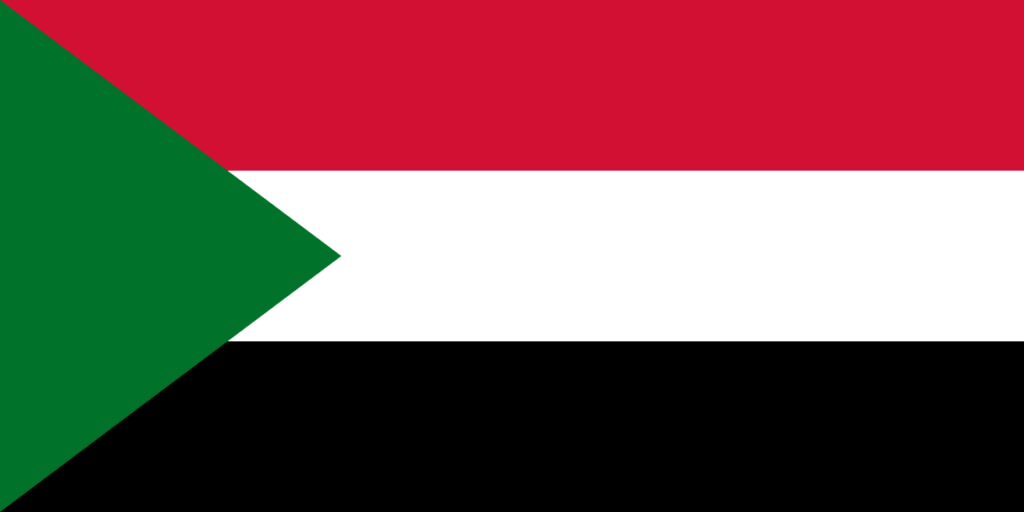
Description: Sudan’s flag also follows the Pan Arab model like Egypt, with a tricolor of red, white, and black. The hoist has a green triangle.
Colors Meaning: the Pan Arab colors symbolize Arab unity and independence. The red represents Sudan’s struggle for independence and the struggle of its martyrs. The white represents the people, light, and optimism. The black represents the people of Sudan and nationalism. The green represents Islam and prosperity.
The flag of Sudan was adopted on 20 May 1970
Flag of Tanzania
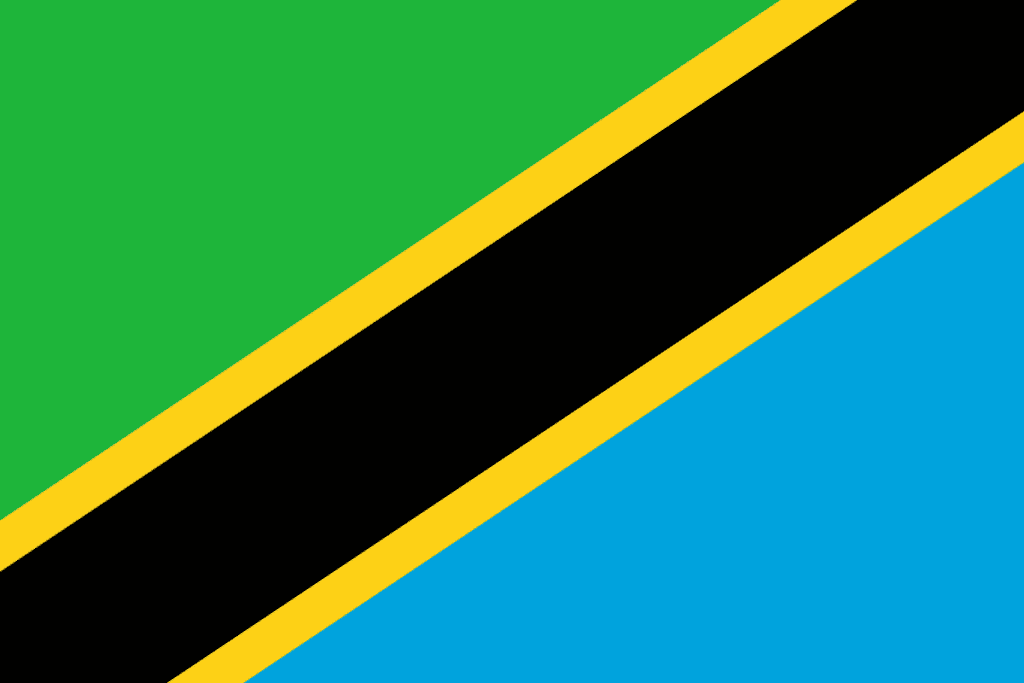
Flag of Tanzania Description: The flag of Tanzania consists of a yellow-edged black diagonal band, divided diagonally from the lower hoist-side corner, with a green upper triangle and blue lower triangle.
Flag of Tanzania Meaning: The colors and symbols of the Tanzanian flag carry cultural, political, and regional meanings. The green alludes to the natural vegetation and “rich agricultural resources” of the country, while black represents the Swahili people who are native to Tanzania. The blue epitomizes the Indian Ocean, as well as the nation’s numerous lakes and rivers. The thin yellow stripes stand for Tanzania’s mineral wealth, derived from the “rich deposits” in the land.
The flag of Tanzania was officially adopted in 1964
Flag of Uganda
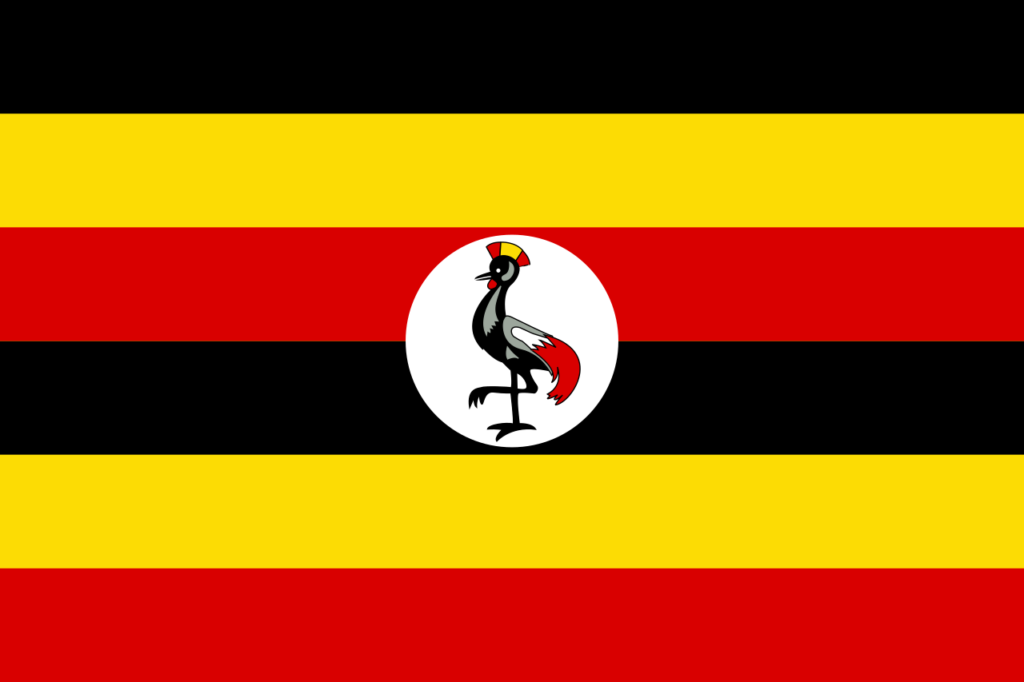
Flag Description: The flag of Uganda looks a bit like the German flag, but has more stripes.
Colors Meaning: The black stripes symbolize African heritage and the fertile soil of Uganda. The yellow stripes represent the sunny days, which are common in Uganda. Red symbolizes the blood of the people and of all of mankind. The crested crane is the national symbol of Uganda.
The flag of Uganda was adopted on October 9, 1962
Central African Flags and their meanings
Flag of Burundi
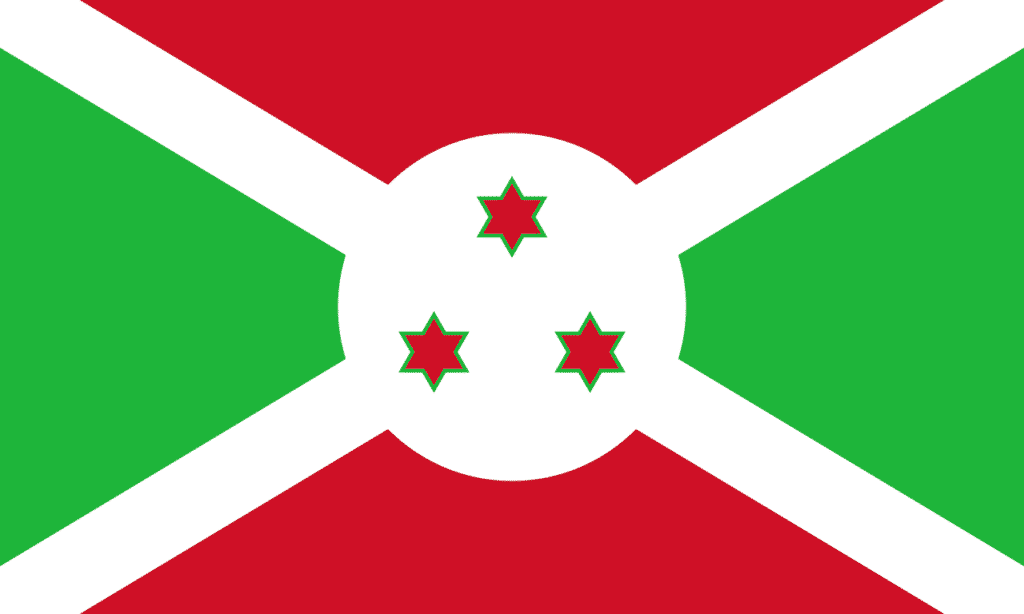
Description: The flag of Burundi consists of a white saltire that divides the field into 4 alternating red and green areas. The center of the saltire merges into a white disk, on which there are three red solid six-pointed stars outlined in green.
Colors Meaning: The green color symbolizes hope, the white symbolizes purity, and the red symbolizes the struggle for independence. The stars represent the three major ethnic groups of Burundi: Hutu, Twa, and Tutsi. The stars also represent the national motto, unity work, and progress. The three stars also stand for the three elements of the national motto: Unité, Travail, Progrès (“Unity, Work and Progress”), which can be seen on the coat of arms of Burundi. They also represent the loyalty that the citizens of the nations have pledged to their God, king, and country.
The flag of Burundi was adopted on March 28, 1967
Flag of Cameroon
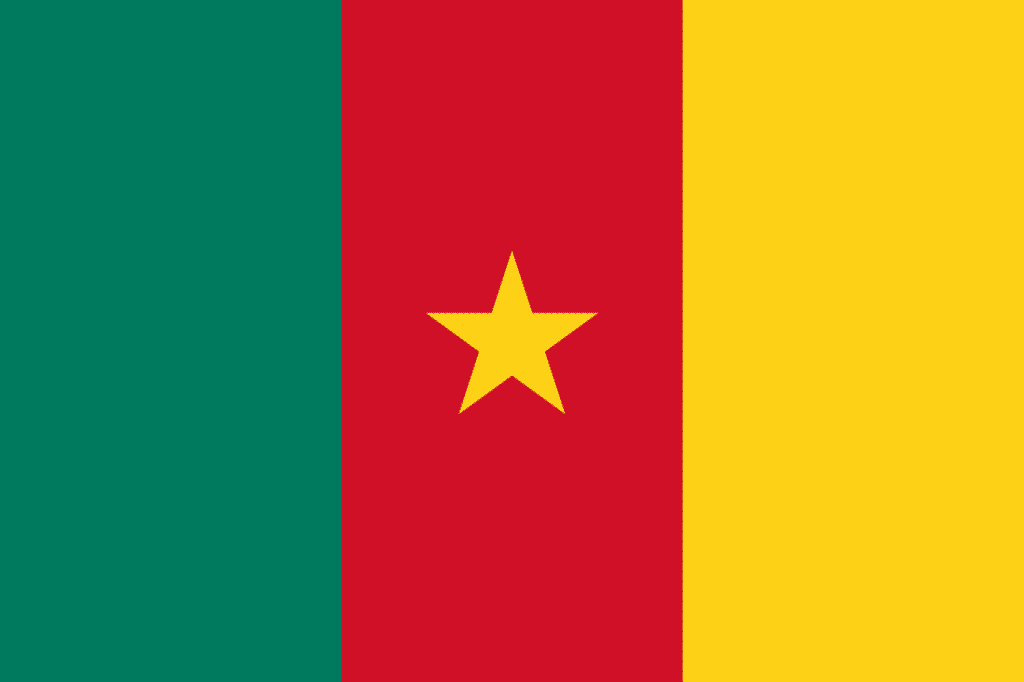
Description: The flag of Cameroon consists of a vertical tricolor of green, red and yellow, with a gold star centered on the red band.
Colors Meaning: The color scheme of the Cameroon flag uses the traditional Pan-African colors. The center stripe is thought to stand for unity: red is the color of unity, and the star is referred to as “the star of unity”. The yellow stands for the sun, and also the savannas in the northern part of the country, while the green is for the forests in the southern part of Cameroon.
The flag of Cameroon was adopted on May 20, 1975
Flag of Central African Republic
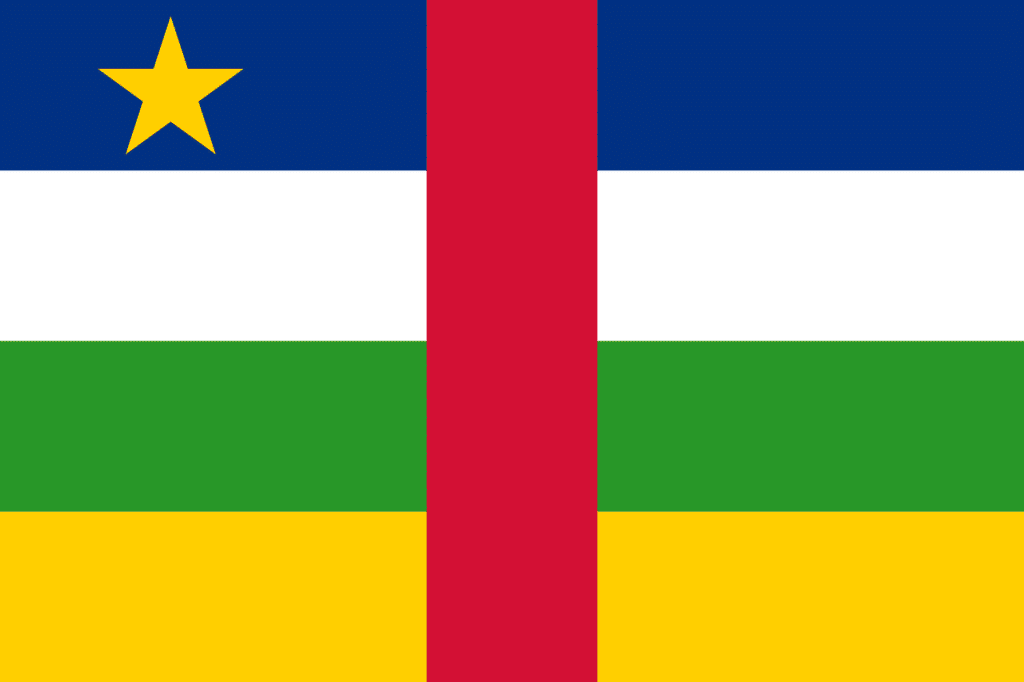
Description: The flag of the Central African Republic was designed as “four equal-sized horizontal bands of the colors blue, white, green and yellow, perpendicularly barred in their center by a red band of equal size and marked in the upper left corner by a yellow five-pointed star
Colors Meaning: The colors chosen are intended to be symbolic of France (blue and white) and Africa (green and yellow) with the red vertical stripe connecting them both in unity, and the respect that Europeans and Africans should have for each other. The yellow star is intended to be indicative of independence.
The flag of the Central African Republic was adopted in 1958
Flag of Chad
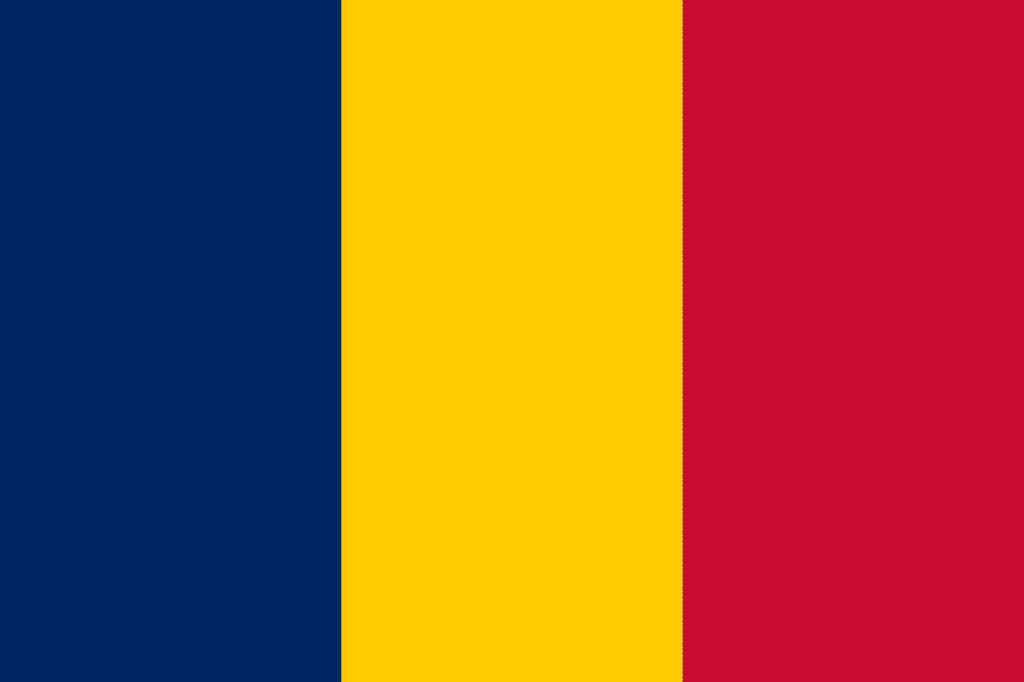
Description: The national flag of the Republic of Chad is a vertical tricolor consisting (left to right) of a blue, a gold and a red field.
Colors Meaning: the blue represents the sky and hope; the gold is the sun and desert, and the red signifies the bloodshed over independence
The flag of Chad was adopted on November 6, 1959
Flag of The Democratic Republic of the Congo (DRC)
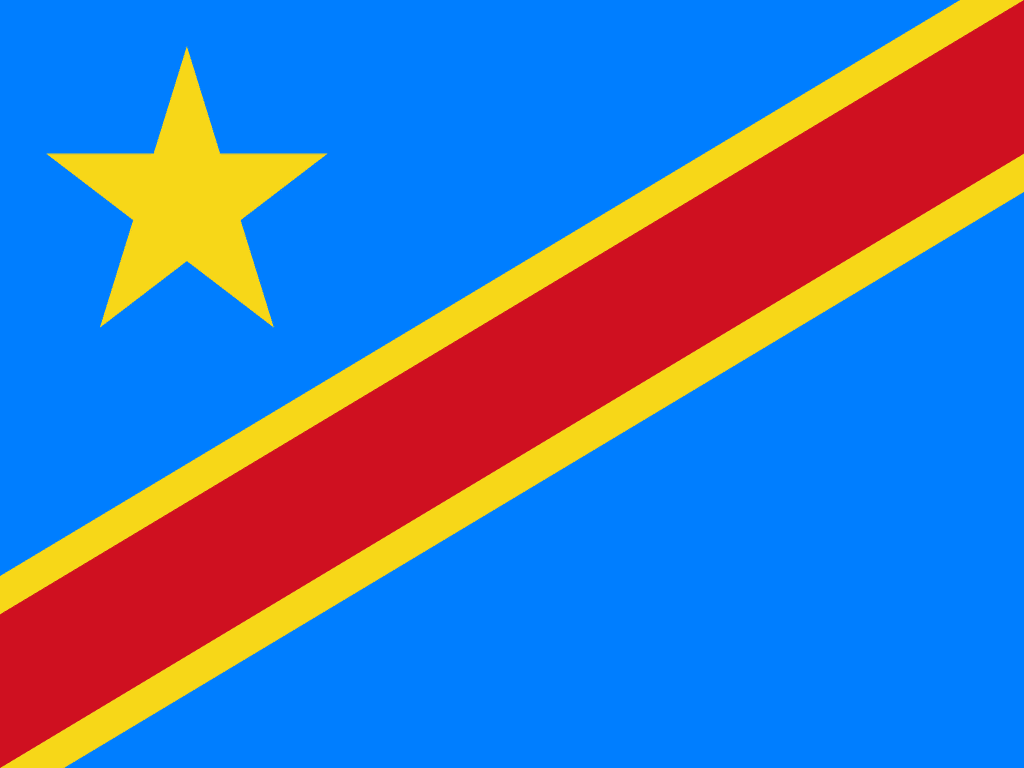
Description: The national flag of the Democratic Republic of the Congo is a sky blue flag, adorned with a yellow star in the upper left canton and cut diagonally by a red stripe with a yellow fimbriation.
Colors Meaning: Blue represents peace. Red stands for “the blood of the country’s martyrs”, yellow the country’s wealth; and the star a radiant future for the country.
The flag of the DRC was adopted on February 20, 2006.
Flag of The Republic of the Congo (Congo-Brazzaville)
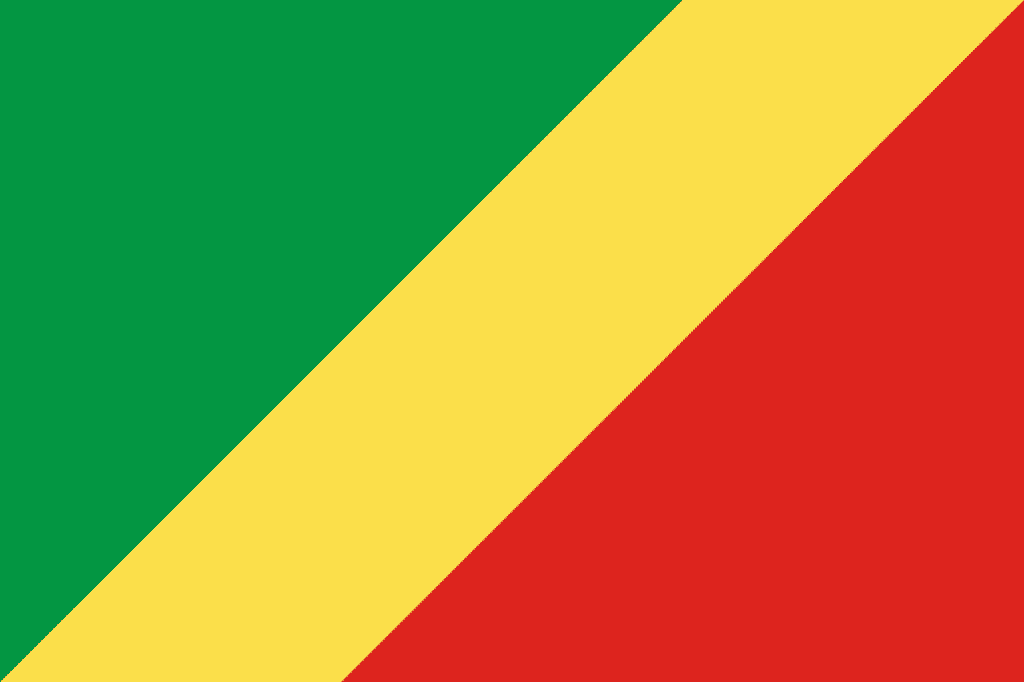
Description: The national flag of the Republic of the Congo (French: Drapeau de la république du Congo) consists of a yellow diagonal band divided diagonally from the lower hoist-side corner, with a green upper triangle and red lower triangle.
Colors Meaning: The colors of the flag carry cultural, political, and regional meanings. The green symbolizes the agriculture and forests of the Congo, while the yellow represents the “friendship and nobility” of the Congolese people. However, the symbolism behind the red was left unexplained. From a continental viewpoint, green, yellow and red are the colors of the Pan-Africanist movement.
The flag of the Congo-Brazzaville was adopted on September 15, 1959
Flag of Equatorial Guinea
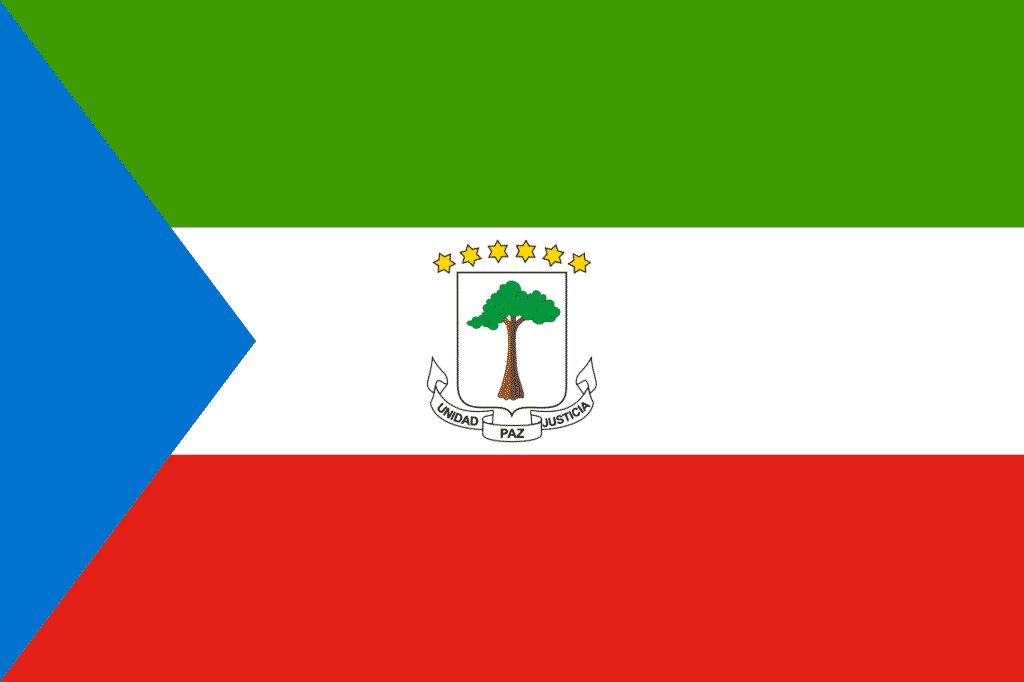
Description: The flag is a horizontal tricolor, with green, white and red stripes and a blue triangle at the hoist. and the National Coat of arms of Equatorial Guinea centered in the white band.
Colors Meaning: Green symbolizes the natural resources, agriculture and jungles of the country. Blue symbolizes the sea, which connects the main country with the islands. White symbolizes peace. Red symbolizes the blood shed by the fighters for independence.
Flag of Gabon
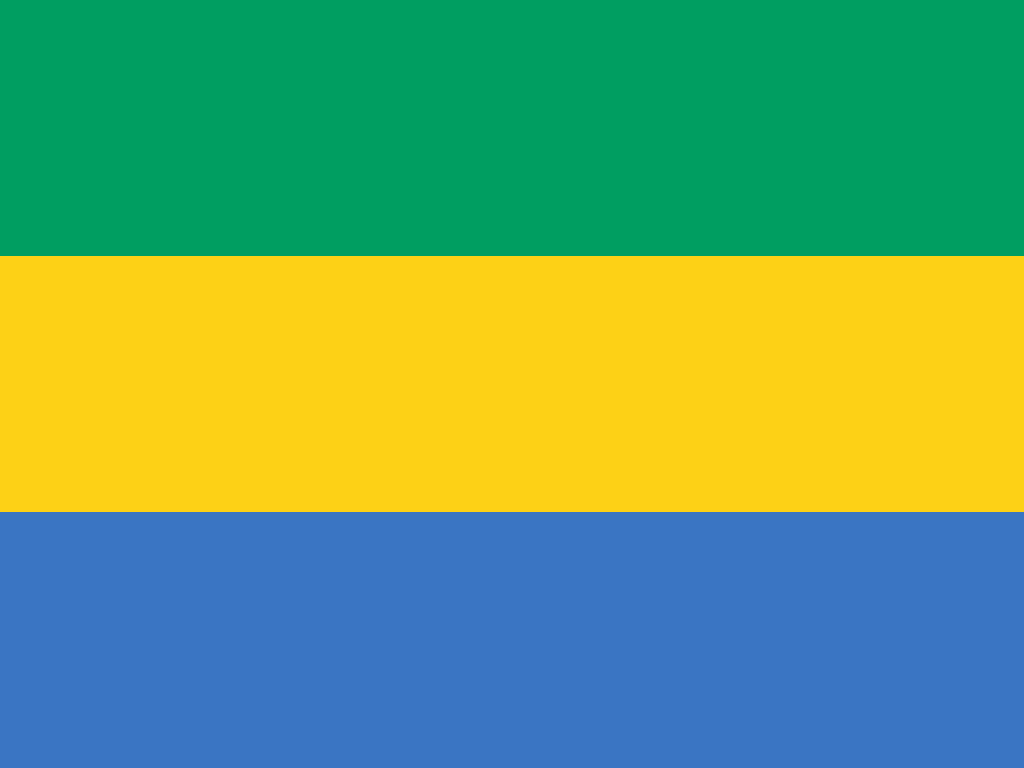
Description: The flag of Gabon has the tricolor green, yellow and blue horizontal bands.
Colors Meaning: Yellow is a symbol of the equator, where the country is situated and also the sun. Blue represents the sea and green represents the county’s natural resources. This flag also carries other regional and political meanings.
The flag of Gabon was adopted on August 9, 1960
Flag of Reunion
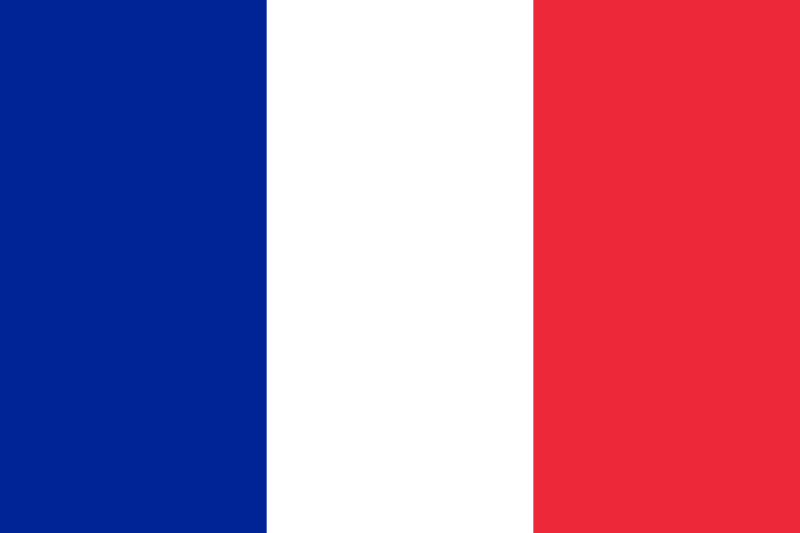
Description: Since Reunion is still an overseas territory of France, it uses the same flag, a vertical tricolor of blue, white, and red.
The flag of Runion was adopted in 1946
Flag of Saint Helena
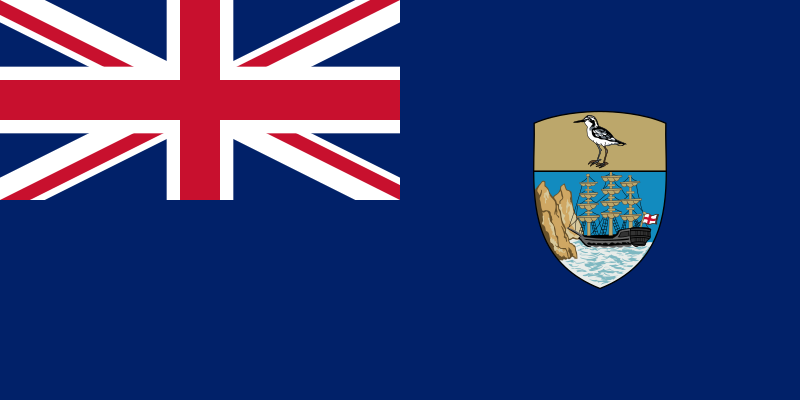
Description: A blue field with a Union Jack in the upper left quadrant. On the right, the coat of arms of Saint Helena rests in the center.
Colors Meanings: The Union Jack and blue color signify that Saint Helena is a United Kingdom territory. The Wirebird on the coat of arms is the national bird of Saint Helena. The ship on the coat of arms shows the importance of shipping and its history.
The flag of Saint Helena was adopted in 1983
Flag of Sao Tome and Principe
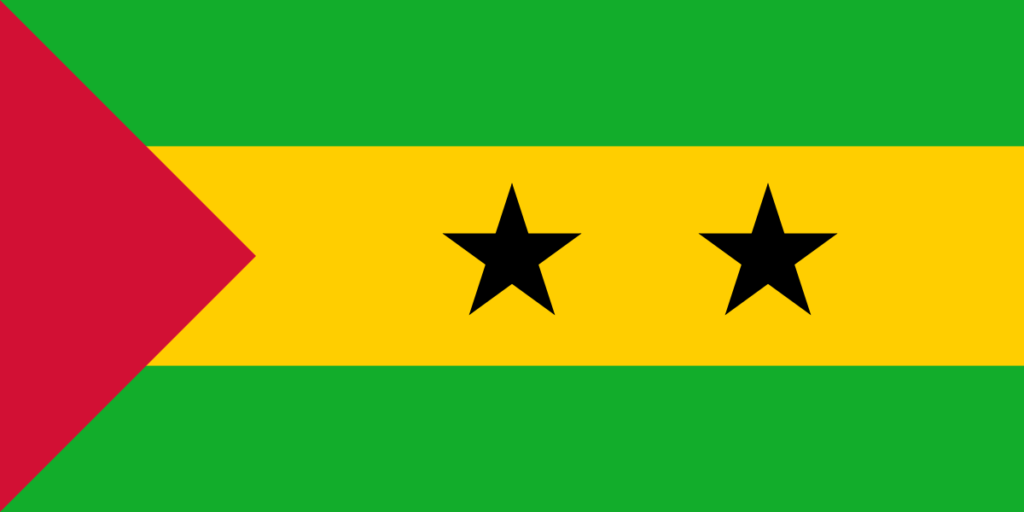
Description: A red triangle at the hoist followed by a horizontal tricolor of green, yellow and green. Two black stars sit on the middle band.
Colors Meaning: The two stars represent the two islands of Sao Tome and Principe. Green represents the vegetation. Yellow is a symbol of the sun and cocoa, a significant resource. Red remembers the struggle for independence.
The flag of Sao Tome and Principe was adopted in 1975
Interesting facts about the African Flags
- 17 African countries have stars on their flags
- 16 African countries’ flags’ contain the symbolic Pan-African colors
- 4 African countries have birds on their flags
- 3 African countries have crescents on their flags
- 2 African countries have 6 colors on their flags
You Might Also Like | Flags of the Arab Countries & the Meaning Behind Them
African flags On Pinterest!
